South Of France Barge Cruising
By Peter Knego
To many, the idea of transport on a barge might seem appropriate for iron ore, grain or some other form of cargo, and of course, that is most often the case.
That noted, savvy QuirkyCruisers also know that some barges have been modified to carry a human contingent on deluxe cruises through scenic and intimate settings.
One of these rarified entities is European Waterways hotel barge Athos, which operates on six-night transits of the eastern part of the Canal du Midi in the South of France.

The privately owned Athos was converted to carry ten guests in 1982 and is operated by European Waterways. * Photo: Peter Knego
Measuring 98.3 by 16.6 feet, the maximum dimensions to transit the locks of the 150-mile engineering marvel, Athos has five staterooms to accommodate ten guests who are tended to by a crew of five.
She was built in 1964 to transport sand, grain and wine but was transformed into her current configuration in 1982, although she still does convey a good selection of wine for the sole purpose of sating her guests.
Athos is actually owned by a private entity and chartered to European Waterways, who operate a fleet of passenger barges on various canals and waterways of Europe.
Her sun deck has a banquet table that seats up to ten under a telescopic awning that was in frequent operation while underway due to the many low-lying bridges on the canal.
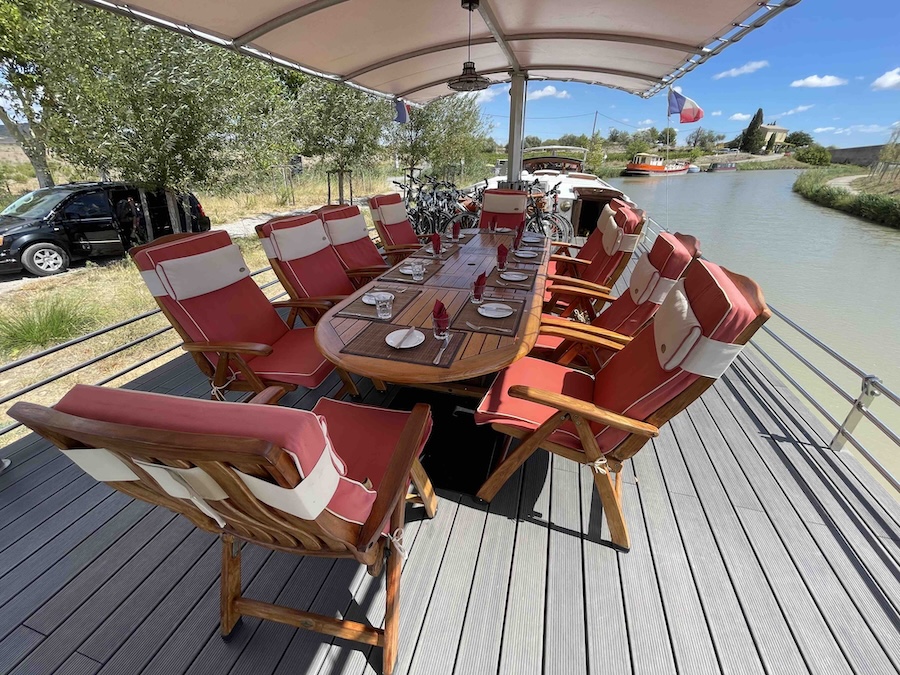
Athos Sun Deck in an aft-facing view. * Photo: Peter Knego
There is also a forward-facing observation area, a jacuzzi, which when covered provided comfortably cushioned seating and sunning vantages and there are eight e-bikes for guests use.
Inside, she has a lovely wood paneled lounge with two large sofas, a self-service bar, a banquet table that seats up to twelve, a small library with French and English publications (most devoted to or inspired by the itinerary) and a selection of board games.
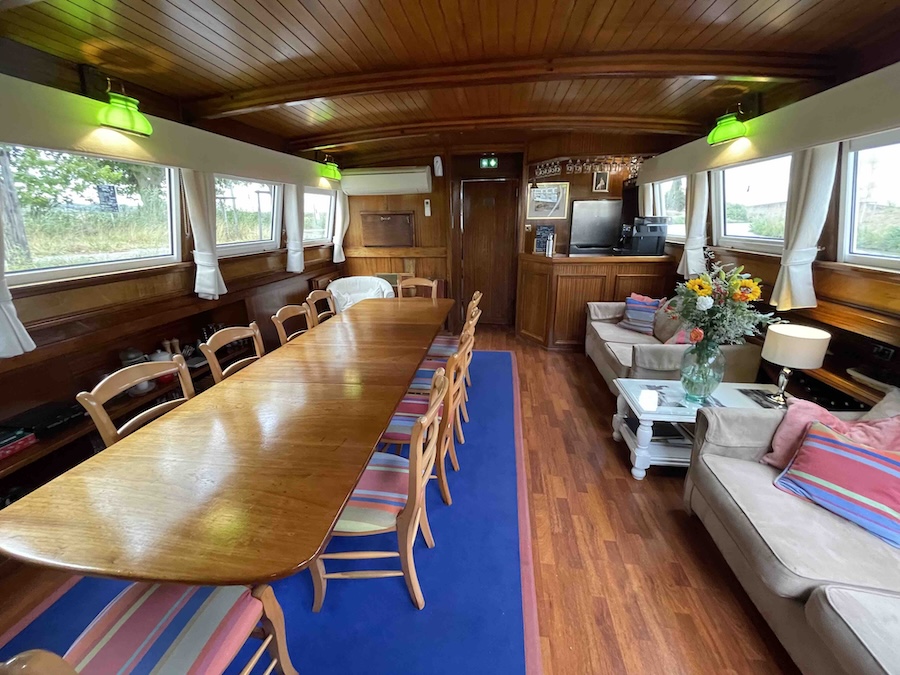
The lounge, shown facing aft. * Photo: Peter Knego
Located just forward of the lounge, there are five staterooms, four of which have a fore-to-aft layout and can be configured as twins or with a double bed. The beds are very narrow and require some getting used to for those of us who toss and turn but they are comfortable, as are the pillows and linens provided.
The aft four measure 88 square feet versus the slightly larger forward stateroom that has an athwartship layout and measures 102 square feet.
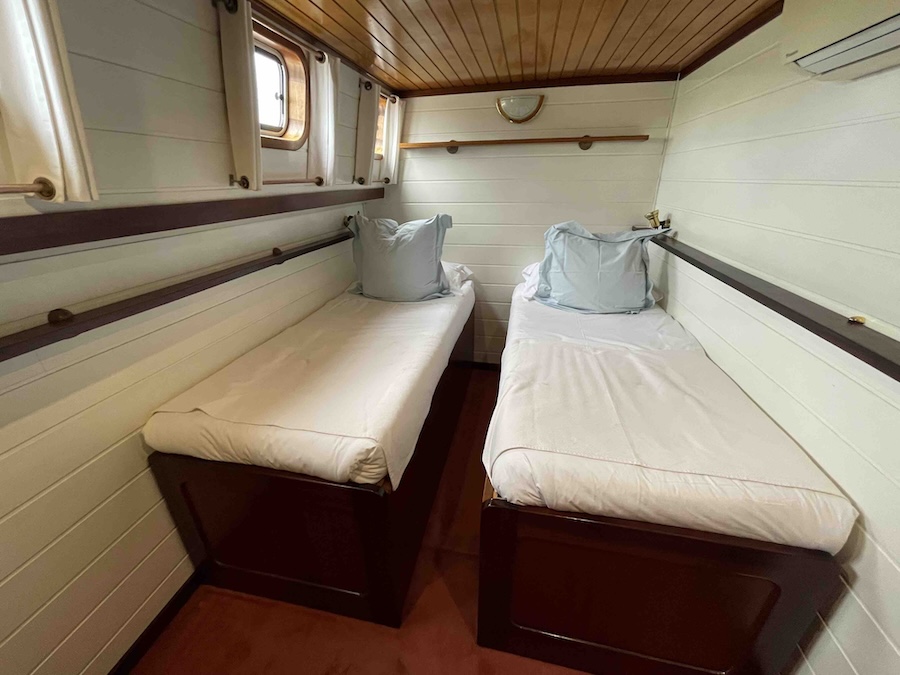
Our stateroom, the St. Saveur, measured 88-square feet. * Photo: Peter Knego
The pricing for all five is the same, so if you book early enough, you may be able to secure the larger room, which is called the Narcissou Fontroide.
All staterooms come with an en suite bathroom that has a shower with a massage head, a toilet and sink. European Waterways supplies Etre brand amenities that include soap, shampoo, shower gel and conditioner.

The bathroom in the St. Saveur stateroom had a shower, toilet and sink. * Photo: Peter Knego
The cabins have individually controlled air conditioning in addition to two small windows in the cabin and one in the bathroom that slide open for fresh air, climate permitting.
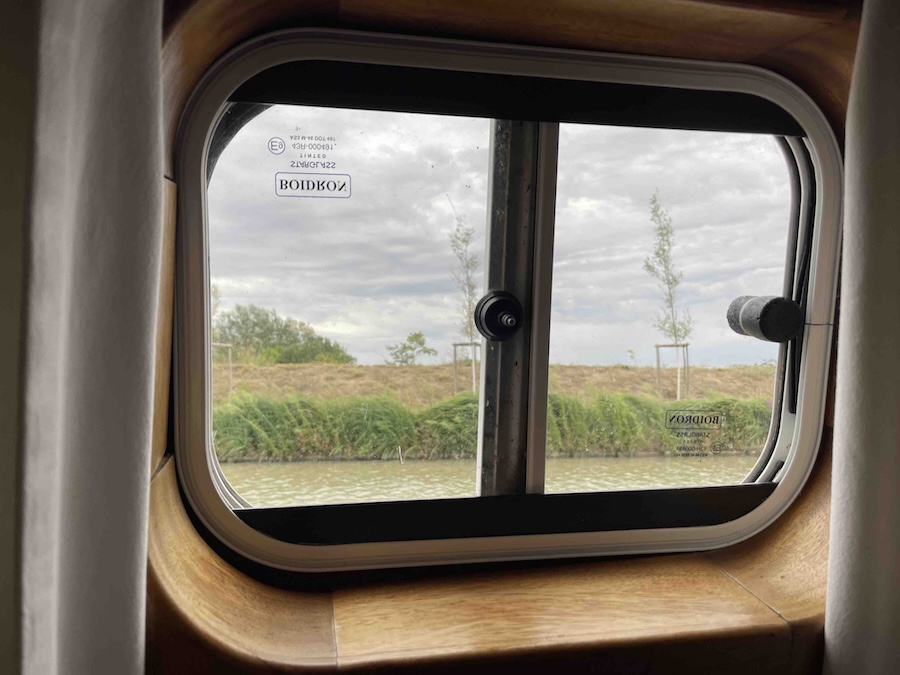
In addition to individually controlled air conditioning, our stateroom had two small windows that could slide open for fresh air. * Photo: Peter Knego
European also provides a charger with two USB ports, which is handy for smart phones and small devices but the electrical outlets are European, so bring an American converter for charging laptops, battery packs, etc.
There is wifi but it was not working on our trip, so I relied on my cellphone data plan and paid a little extra for more bandwidth from T-Mobile.
Each cabin has a tall, narrow closet but pack lightly, if possible, since the dress on board is very casual and no fancy clothes, suits or cocktail dresses are needed. That noted, we were combining this trip with another one that was a bit dressier and arrived with far too much luggage.
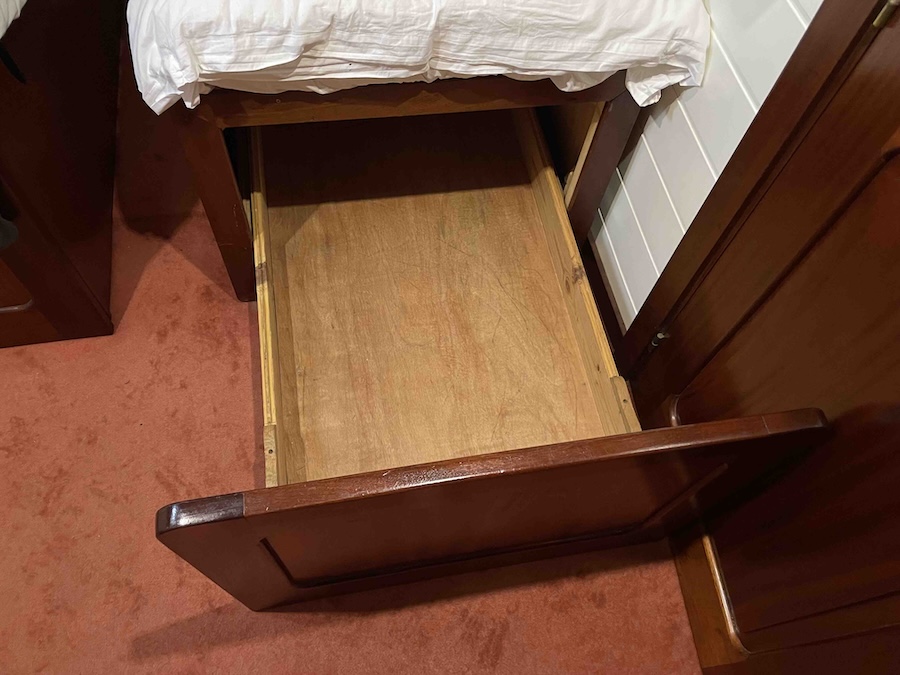
In addition to a small closet for storage, the bed boards slid open with a good deal of space for suitcases and used clothing. * Photo: Peter Knego
One thing that really helped in our circumstance was the space under the beds, which could be accessed via sliding open the footboard. It was very handy for stowing our bags and dirty laundry.
There is no laundry service offered so make sure you pack plenty of essentials like socks and underwear to get through the week.
VIDEO: See Peter’s full video tour of his week aboard the Athos.
Subscribe to our monthly small ship cruise email
Subscribe to QuirkyCruise.com for monthly curated newsletters highlighting our top small cruise ship reviews, round-ups & offers!
Day One: Beziers To Argeliers
Our South Of France barge cruising journey began in the charming town of Beziers, which is one of the oldest cities in France, dating to 575 BC. We were already in the region on another trip that ended in Lyon, so took the train, which, once past the chaos of the train station, was a delightfully scenic 186 mile journey with only a couple stops en route.
The Beziers train station is at the foot of a small hill that leads to the main part of town and taxi service there leaves much to be desired, so be prepared to roll your luggage a kilometer or so up narrow streets or through the more scenic but somewhat steep (in parts) park across from the station.
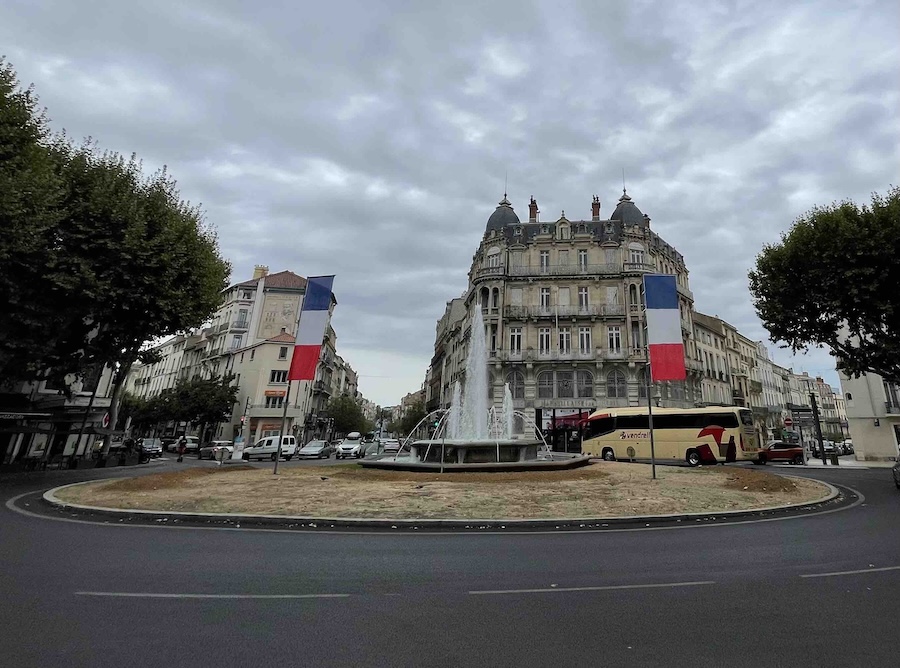
The main city square of Beziers. * Photo: Peter Knego
Beziers has a wonderful city square lined with cafes, a gorgeous old opera house and a maze of small streets with shops and cafes that lead to the St. Nazaire Cathedral at the top of the acropolis.
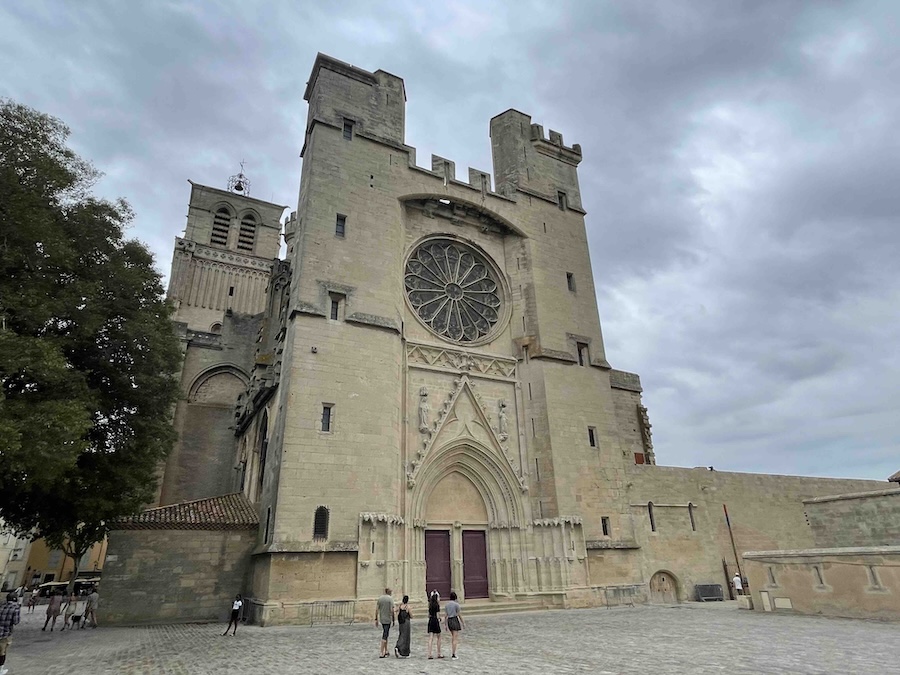
The most popular attraction in Beziers is the St Nazaire Cathedral, which was completed in the thirteenth century. * Photo: Peter Knego
The view from the base is lovely enough but if you are willing to brave a narrow spiral stone staircase with two way traffic to get to the ramparts of the cathedral, you will be rewarded with a magnificent view of the Languedoc-Rousillon countryside and the River Orb, which passes directly below.
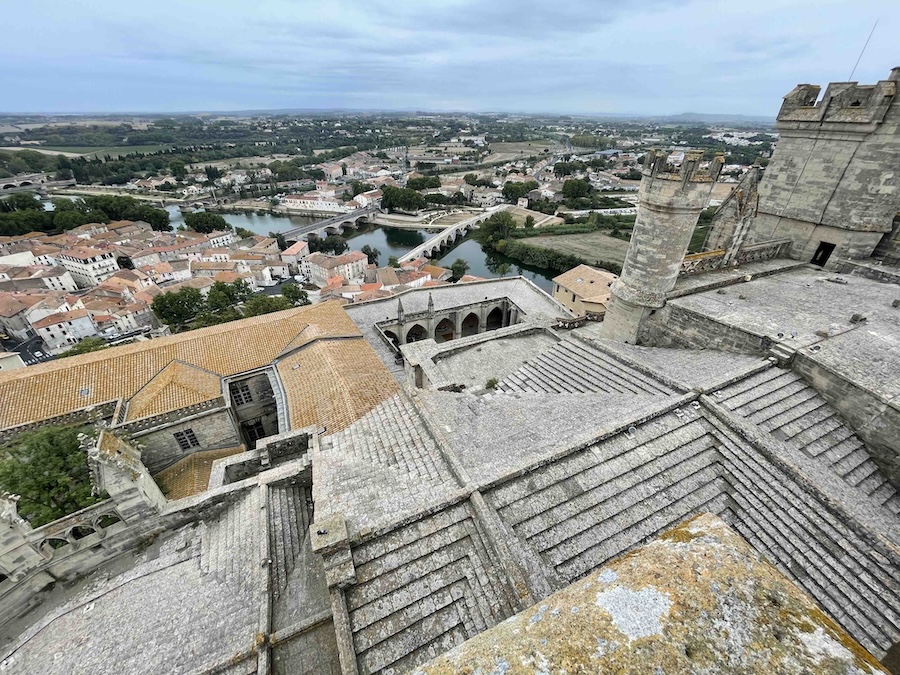
Facing south over the River Orb and the bridges at the base of the Cathedral of St. Nazaire in Beziers. * Photo: Peter Knego
The Cathedral of St Nazaire dates from the thirteenth century and makes a magnificent backdrop for the gorgeous Medieval stone arch bridge, Pont Vieux, that crosses the Orb at the foot of its base.
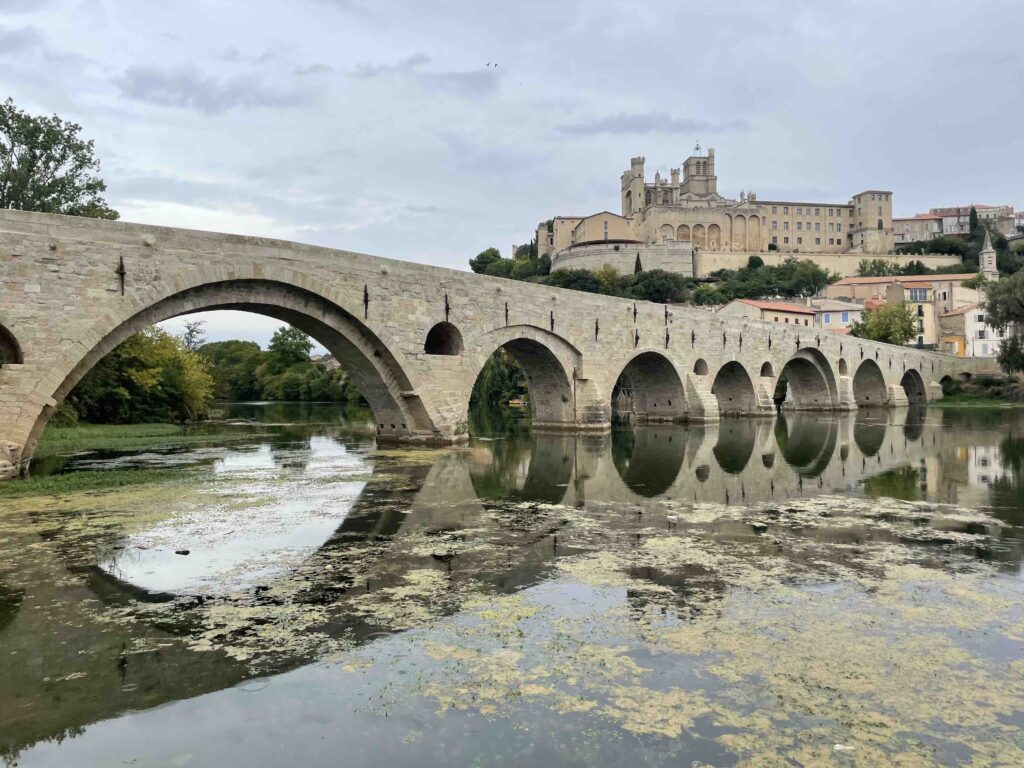
Pont Vieux with St Nazaire lurking overhead. * Photo: Peter Knego
Behind the cathedral, a series of stairs and a trio of lifts deliver visitors to the bridge, which is one of four that cross this part of the river. The other bridge of note is the aqueduct bridge, which was built in 1858 as an extension of the Canal.
We spent a night in Beziers and enjoyed the following morning on our own before being picked up in minivans driven by the Athos friendly captain Pierre-Yves and tour guide Matthieu.
Once all 10 guests were gathered from our various hotels (usually between 4:00 and 4:30 PM), we were off on a 20-minute ride to Argeliers, a town with some 2,000 residents about 22 kilometers west of Beziers.
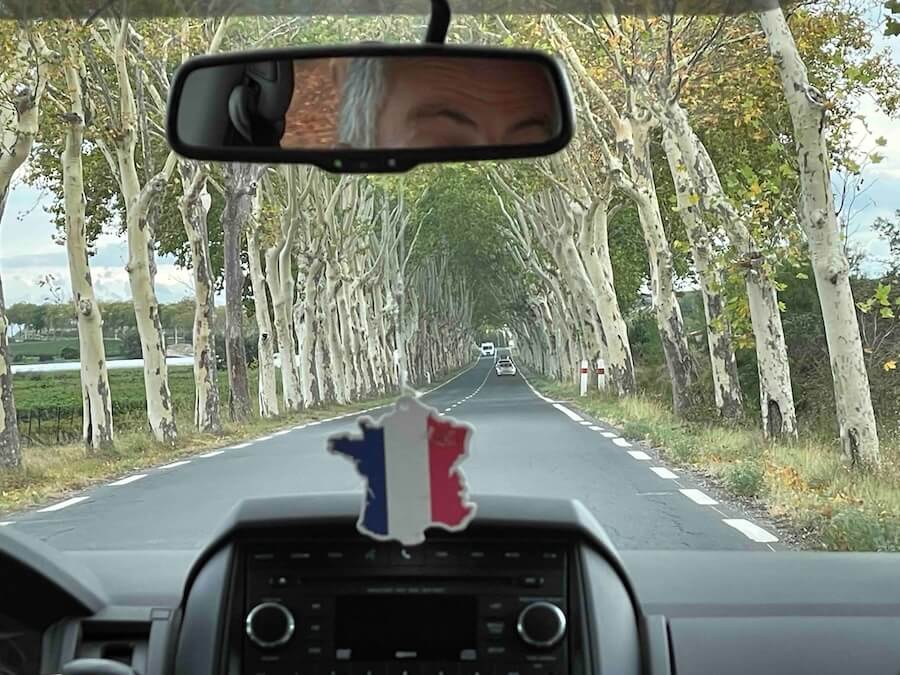
Taking the high road to Argeliers. * Photo: Peter Knego
We first encountered Athos berthed east of the village on a bend in the canal near a stone arch bridge, adjacent to a grassy meadow. Named for one of the Three Musketeers, who was known for his generosity, charm and handsomeness within a “steely” exterior, the Athos is, indeed, a handsome vessel with her black hull, red trim and glistening white superstructure.
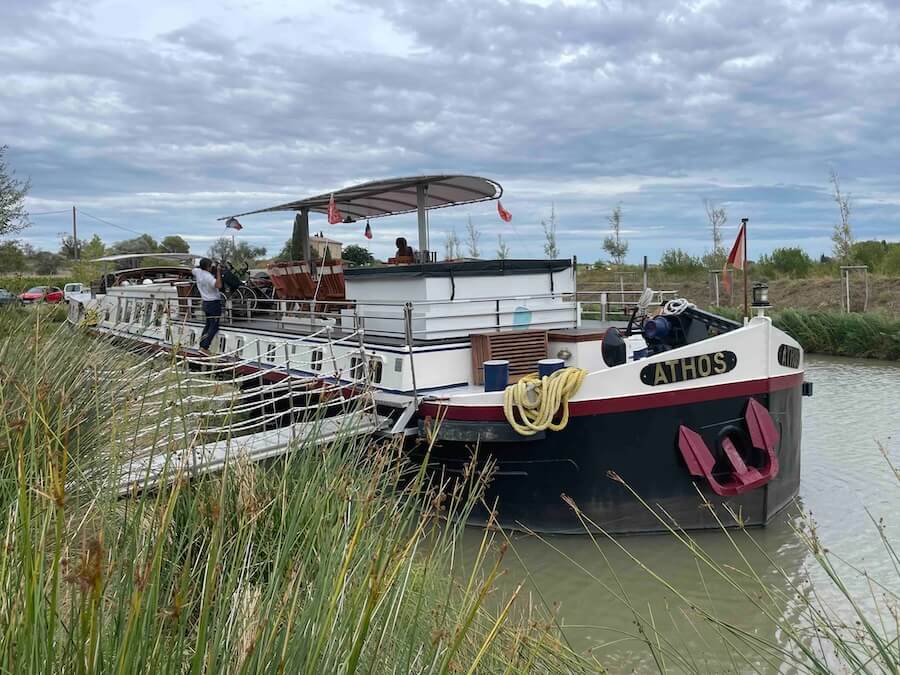
Our first encounter with our floating home for the next six nights, the barge Athos at Argeliers. * Photo: Peter Knego
As the crew hauled our luggage on board, we followed suit and were shown to our cabins, then had some time to unpack and relax. My companion Mike and I took that opportunity to go for a 5K run through the village and along a local highway that meandered through the vineyards and farmland, making it back with barely enough time to shower and join our fellow voyagers for dinner.
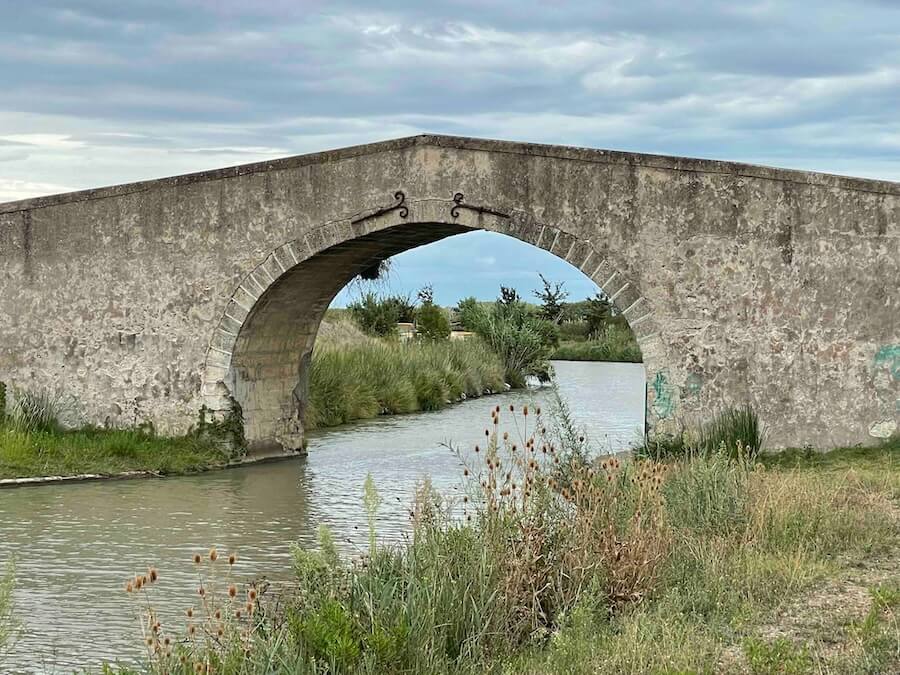
A beautiful stone arch bridge was just a few steps away from where the Athos berthed in Argeliers. * Photo: Peter Knego
Aside from breakfast, which was always served in the Lounge, most meals were enjoyed on deck. There is a fixed dinner menu with fresh baked breads and creamery butter, a starter course and an entrée paired with a select white and red wine, followed by dessert and cheeses.
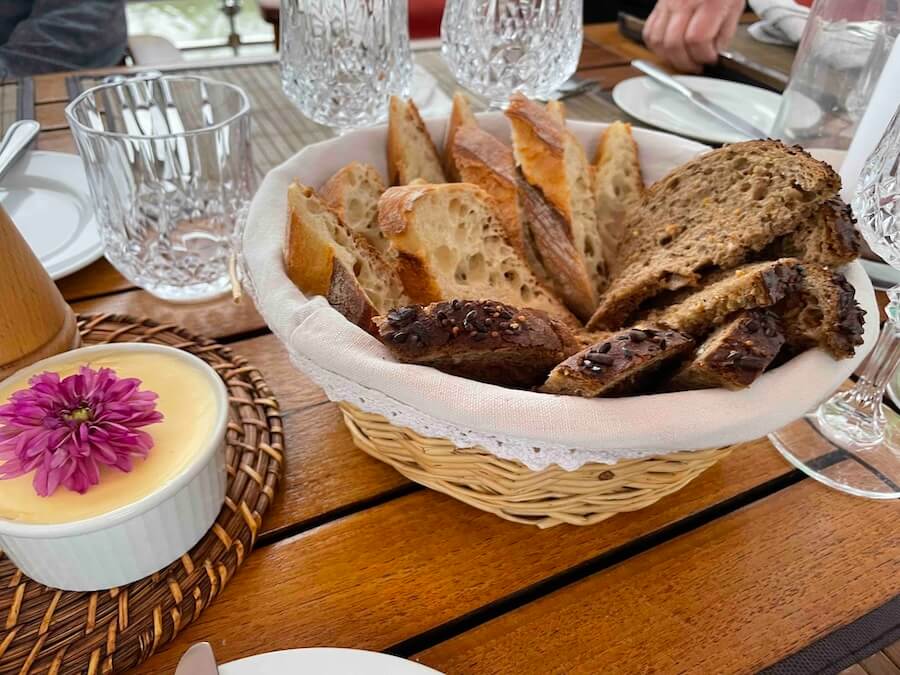
Beautiful breads and creamery fresh butter accompanied each meal. * Photo: Peter Knego
The two charming hostesses, Emily and Georgia, provided some background info on the wines and cheeses and chef Josh introduced the courses, in this first instance, a saffron risotto starter, an osso buco entrée and a marinated pear in cinnamon-laced whipped cream for dessert.
Our fellow guests included a couple from Michigan, a couple from San Diego and two couples from Alameda, California, with ages ranging from early 50s to early 70s. Two of us had dietary restrictions that were handled with finesse.
One guest was mostly vegetarian with the exception of fish and shellfish (also known as a Pescatarian) and the other is mostly vegetarian but fine with poultry and cooked fish, although he does not eat shellfish.
Full disclosure: I am that second guest and under any circumstances am just fine saying I am vegetarian to make it easier for all concerned but our diets were no problem for Josh and with some meals that involved beautiful salads and cooked fish, there was no need for substitutions. That first night, fish and chicken alternatives were discretely served and they were absolutely delicious.
After the wine was poured, our host and guide Matthieu welcomed us and, as he would for the rest of the week, provided some background on the following day’s itinerary.

Matthieu welcomes us on board Athos and explains what we will be doing on the next day’s excursions. Photo: Peter Knego
Matthieu had worked with deluxe French cruise line Ponant for many years, which explained why he was especially savvy with his organizational and diplomatic skills throughout the voyage.
With a brilliant pink sunset illuminating a canvas of fluffy puffs of clouds overhead, good company and a magnificent meal fortified with local wines, our Canal du Midi adventure was off to a perfect start.
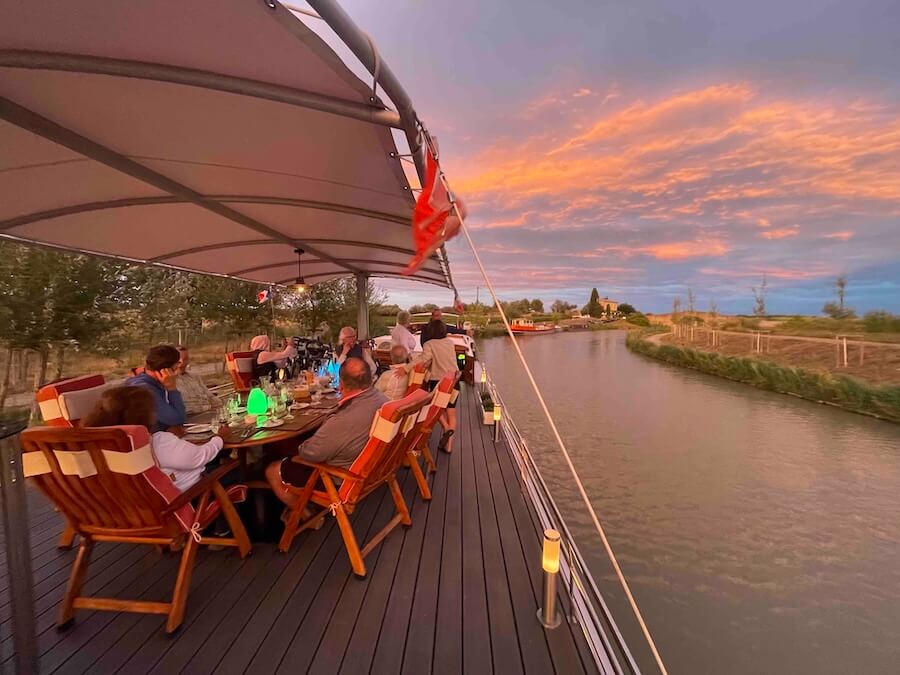
A beautiful sunset over the canal serenaded our first dinner on board Athos. * Photo: Peter Knego
Day Two: Argeliers To La Croisade
The following morning, we were up early to make our 9:00AM departure for the double walled Medieval citadel of Carcassone, which is some 30 miles east of Argeliers. Matthieu emphasized that our early visit would be free of the crowds that would descend upon the place later in the morning.
But first, there was breakfast. Unlike most meals (unless it was too windy or rainy), breakfast was served in the lounge.
Of prime importance to this caffeine addict was the coffee machine, which was put to good use as it cranked out cup after cup of espresso (but sorry, no cappuccinos) with a choice of brown and white sugar nearby and cream in the fridge behind the bar.
The breakfast spread included a selection of delicious cheeses and fresh baked breads, pastries, succulent melons and berries, yogurt, granola, cold cuts and eggs, which were either soft or hard boiled. It was great for fueling up in the morning but could have been improved with eggs-to-order like an omelet, scrambled or over-easy — anything to break the monotony of boiled eggs every day.

A sampling of the pastries, fresh breads and a dash of local honey for breakfast. * Photo: Peter Knego
At 9:00AM precisely, our mini-van caravan was on its way across the gorgeous countryside of Languedoc-Rousillion, passing under a vibrant rainbow that did its best to double before vanishing.
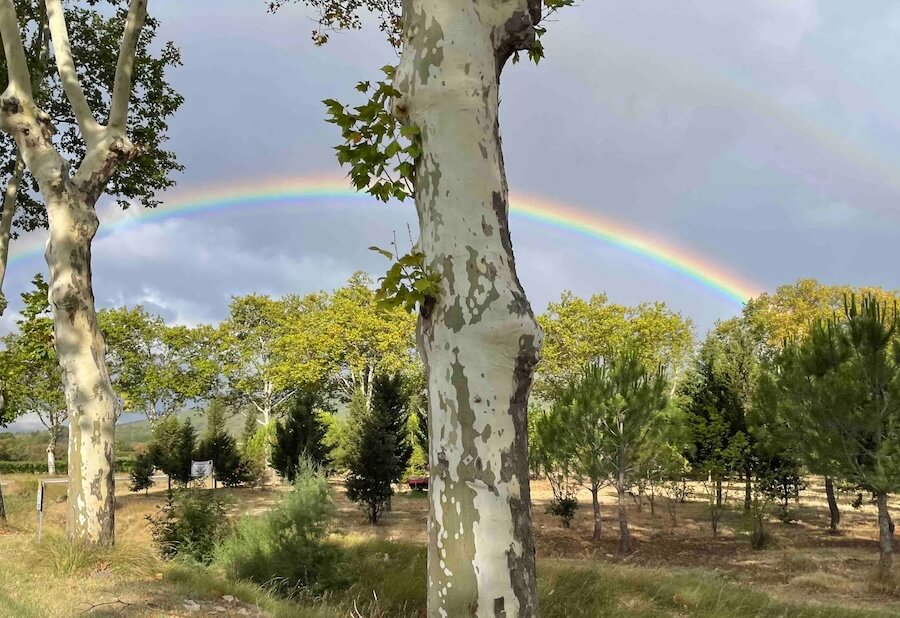
Somewhere under the rainbow on the road to Carcassone. * Photo: Peter Knego
When we arrived at Carcassone, the parking lot was mostly empty. We first gathered beneath a frieze of Lady Carcas, the legendary Queen of Navarre who defended Carcassone from Charlemagne, which presided over the drawbridge entrance to the citadel.
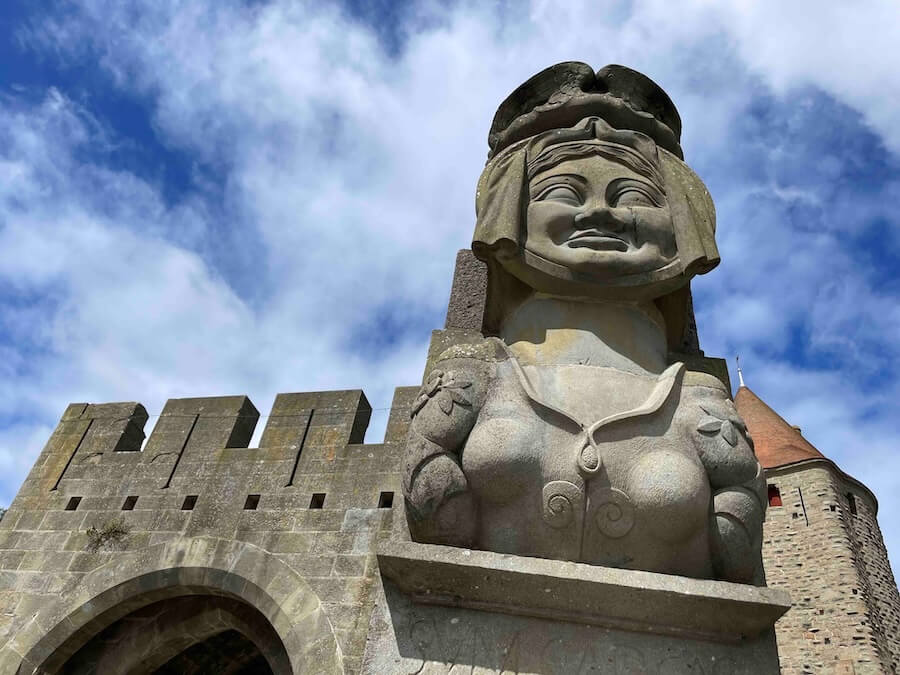
The legendary Lady Carcas guards the entrance to the Medieval citadel of Carcassone. * Photo: Peter Knego
This would be the rendezvous point for those who took time to explore on their own.
Matthieu provided the historic background on Carcassone in an entertaining and engaging way, avoiding the perceived drudgery of too many dates and statistics.
He began by showing us what was left of the Roman fortifications before taking us to the cathedral, which has some particularly nice stained glass panels, and then to a lookout on the grounds of the local hotel.
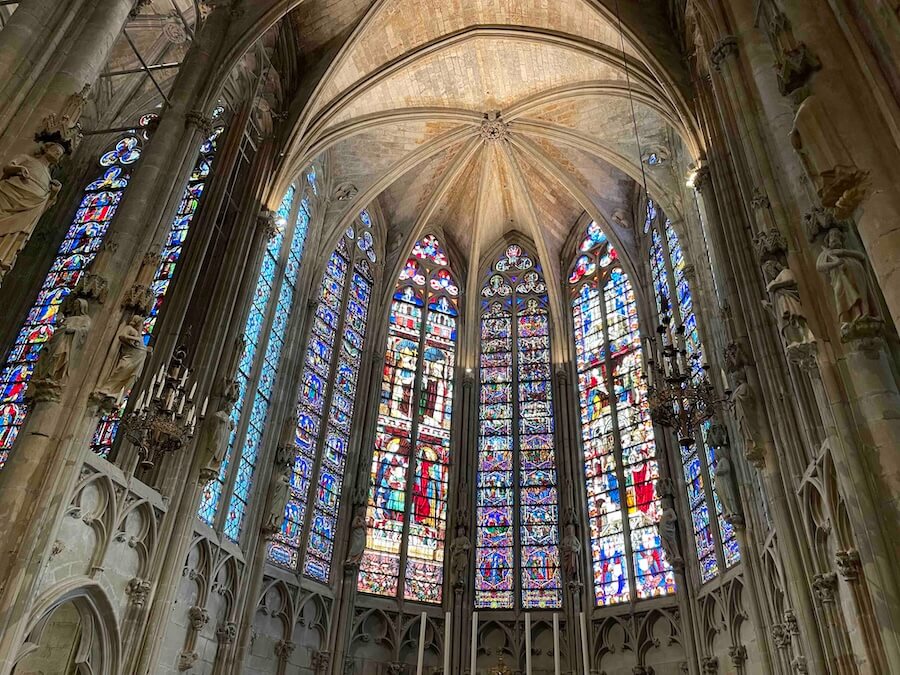
A small section of the stained glass windows in the cathedral of Carcassone. * Photo: Peter Knego
From there, we had a choice of shopping or touring the outer wall, which provides spectacular views of the citadel and the neighboring region.
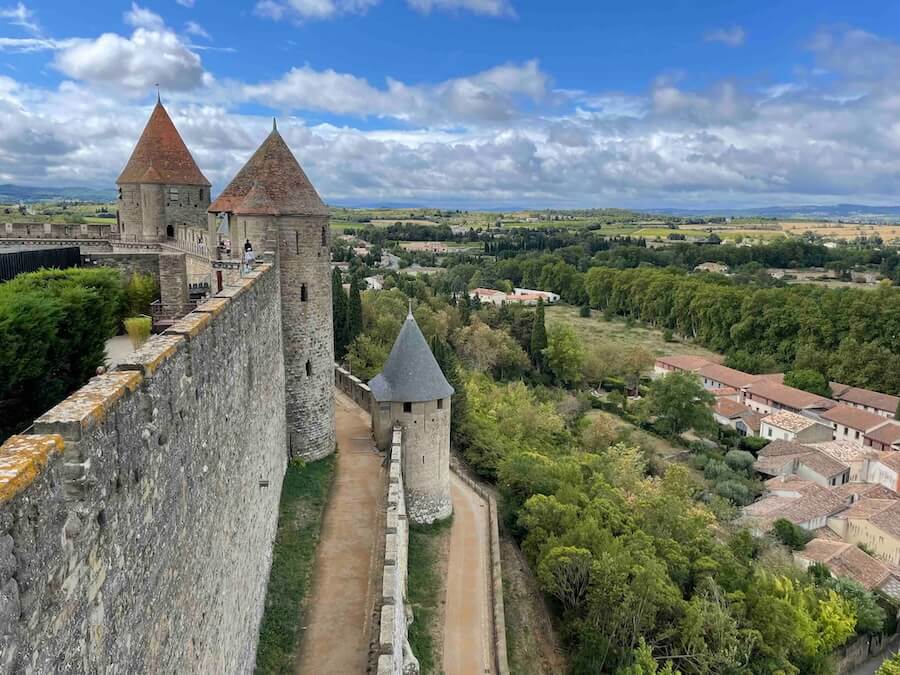
Fairytale views from the ramparts of Carcassone. * Photo: Peter Knego
Mike and I chose the latter, making it back just in time to reunite with our fellow guests underneath Lady Carcas’ asymetrical stone bosoms. By that time, the place was inundated with tourists, so, of course, Matthieu’s prediction was spot on.

The cathedral from the walk along the outer wall. * Photo: Peter Knego
As soon as we returned Athos, her lines were cast and she began a westbound loop of scenic cruising to the convergence of the Canal du Midi with the Canal de la Robine, then turned around to begin her eastbound journey.
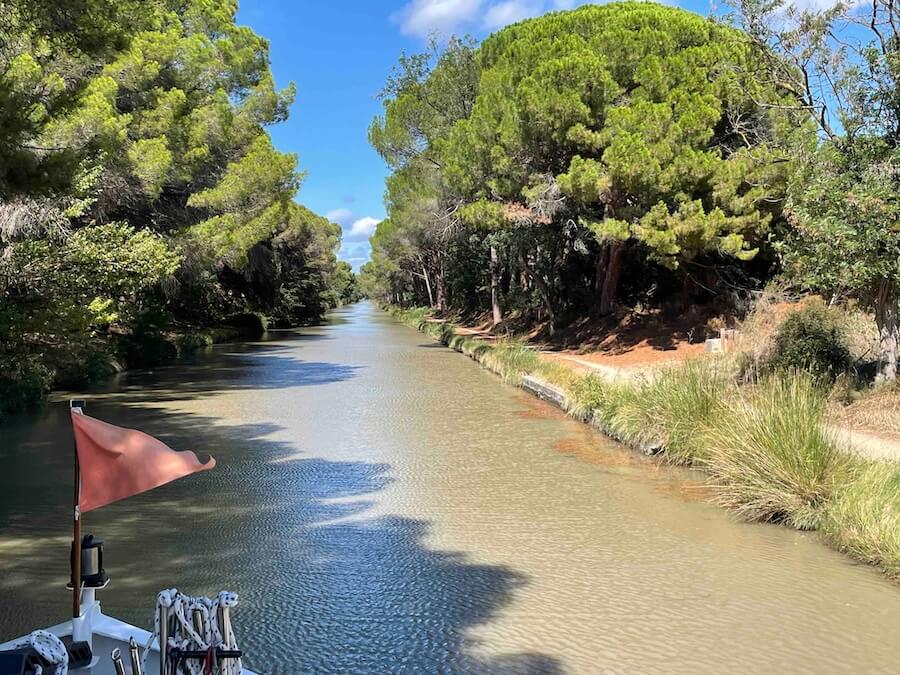
Our first cruise segment along the Canal du Midi. * Photo: Peter Knego
Our itinerary would span only the eastern 40 miles or so of the Canal, which was built between 1666 and 1681 as part of a two canal system called Le Canal des Deux Mers (or two seas) designed to link Bordeaux on the Atlantic with the Mediterranean.
The western portion of the waterway, the Canal du Garonne, stretches from the Garonne River to Toulouse, where it meets up with the Canal du Midi, which then winds its way east to a salt water lagoon on the Mediterranean coast called Etang de Thau. One of Europe’s most lauded man-crafted marvels of its time and one of the oldest active canals in Europe, Canal du Midi was commissioned by the “Sun King” Louis XIV and was the brainchild of engineer Pierre Paul Riquet, who was from Beziers.

The Canal du Midi runs from Toulouse to the Etang de Thau on the Mediterranean coast of France. * Map: Athos
Even before we were underway, the al fresco banquet table was set and a nice regional rose was being poured. Much like dinner, lunch was a two course affair, beginning with a starter that often included fresh-from-the-local-marketplace salads like that day’s carrot and chickpea and a “couscous with seeds” salads.
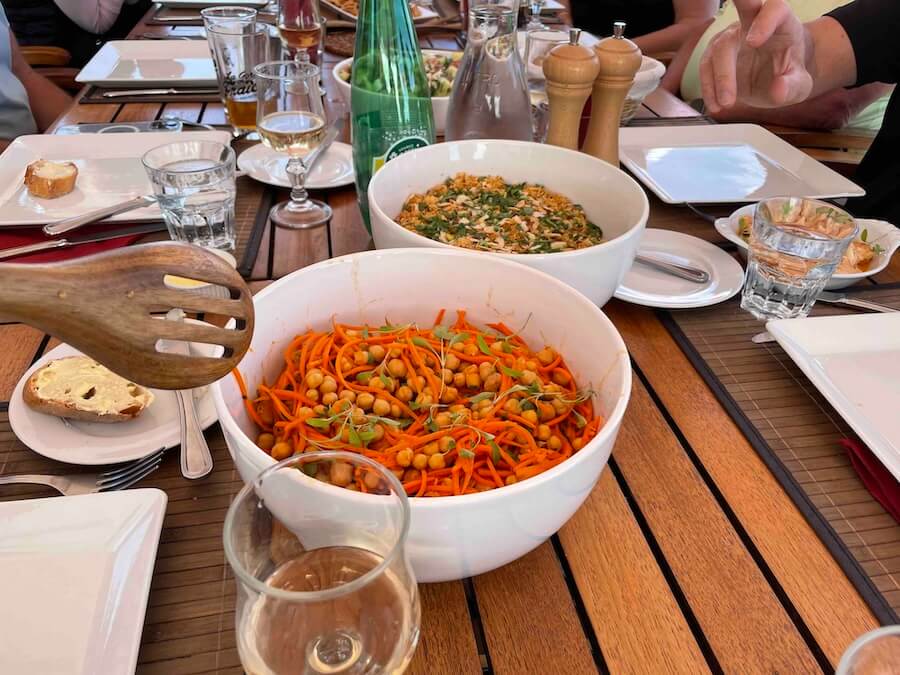
Carrot and chickpea and couscous with seeds salads started off lunch on deck. * Photo: Peter Knego
For the main course, a spicy Spanish chicken with or without chorizo or for those who prefer fish, a roasted sesame tuna.
With a refreshing following breeze and the gorgeous scenery, which includes a tow path frequented by hikers and bicyclists on the south side of the canal, it was one of many perfect meals we would enjoy that week.
Another amusing highlight of our midday canal transits was the telescopic awning that would lower over the table as we crossed under each bridge, just clearing our seated heads. Our dedicated captain somehow managed to keep his eye on all the bends, oncoming traffic and overhead clearance during each passage, most of which lasted just a couple of hours before the Athos tied up in her next destination.
That day, the next destination was La Croisade, another rural spot located near a small restaurant and another picturesque stone arch bridge. Once we were secured, we were off in the two minivans (which followed us from Argeliers) to the foothills of the St. Chinian region to a fascinating winery called Chateau Castigno.
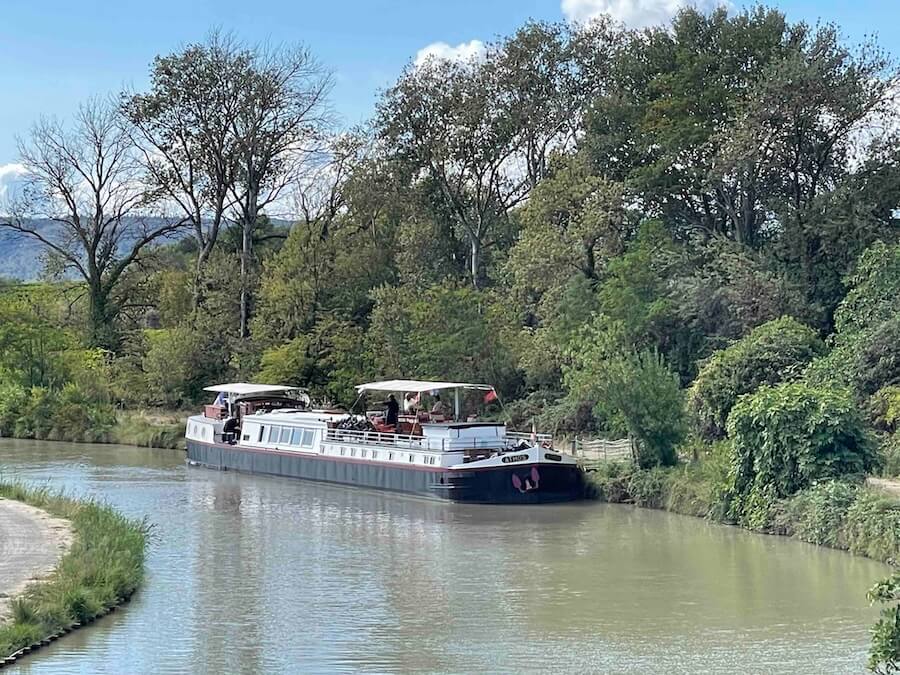
The Athos at La Croisade. * Photo: Peter Knego
The cellar and tasting room, designed by Belgian architect Lionel Jadot, are built in the form of a giant wine bottle that towers over the vineyard.
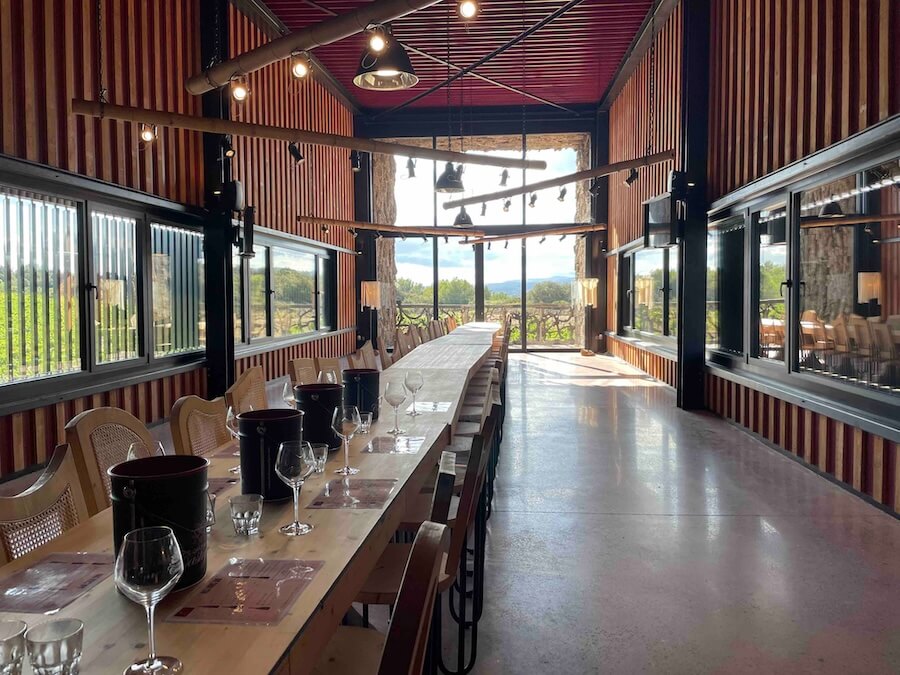
The tasting room at Chateau Castigno. * Photo: Peter Knego
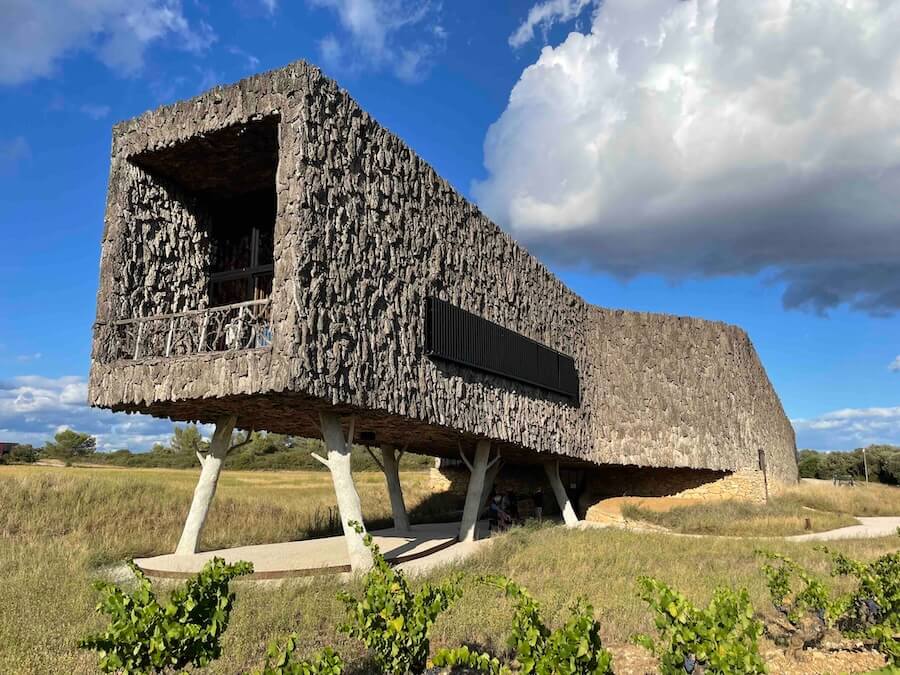
The spectacular exterior form of Chateau Castigno was designed by architect Lionel Jabot to resemble a wine bottle. * Photo: Peter Knego
We were given a tour, then enjoyed a sampling of five wines before we had some time to walk around the site, which looked stunning in the golden afternoon light.
We made it back to the Athos just before dinner and yet more wine on deck as the sun set, marking the end of another magical day.
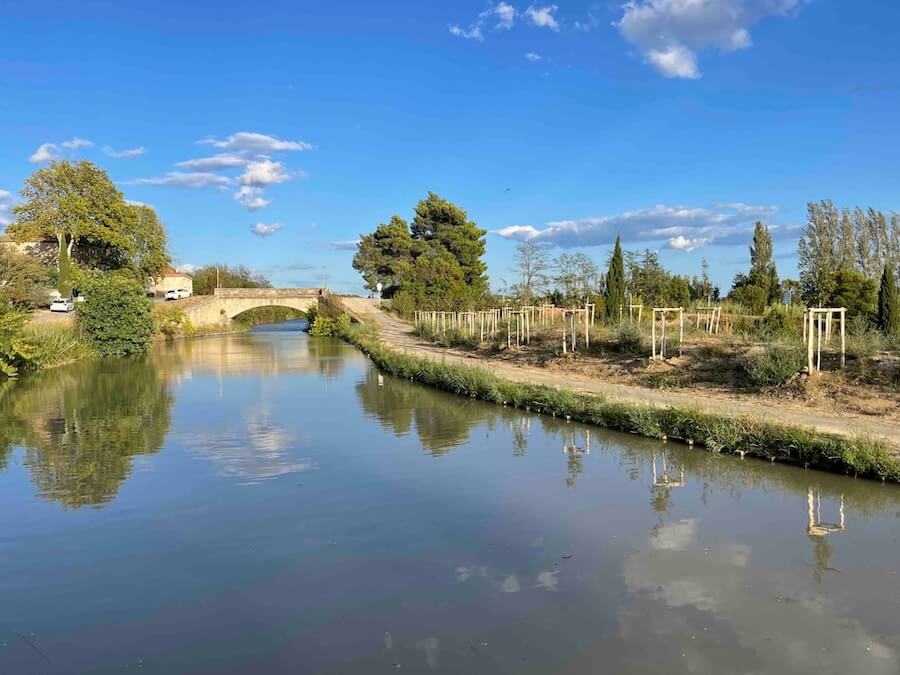
La Croisade on our second afternoon aboard Athos. * Photo: Peter Knego
As it was getting a bit breezy, we enjoyed dinner in the lounge.
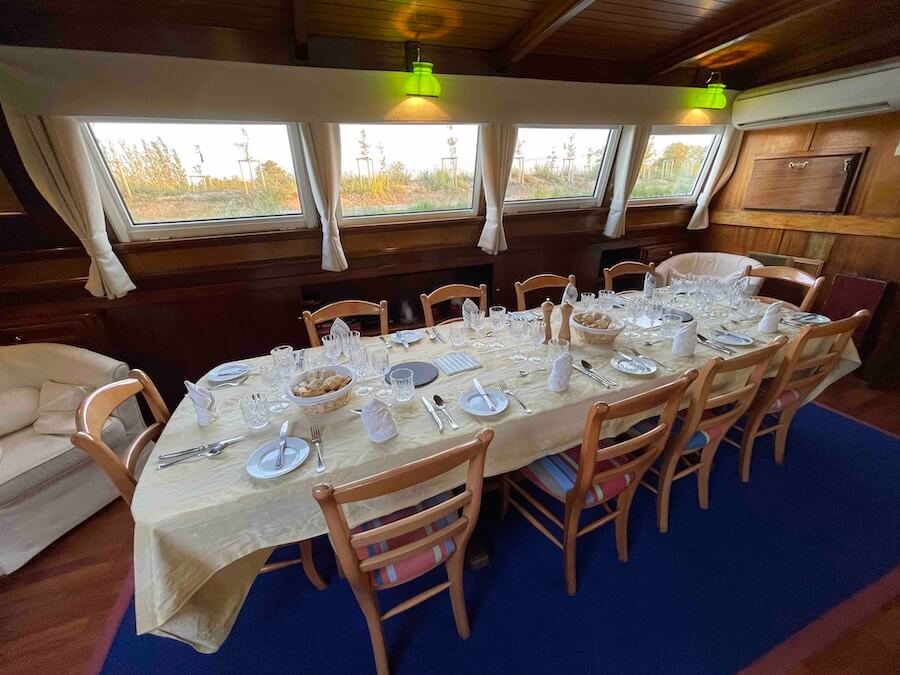
The lounge set up for dinner. * Photo: Peter Knego
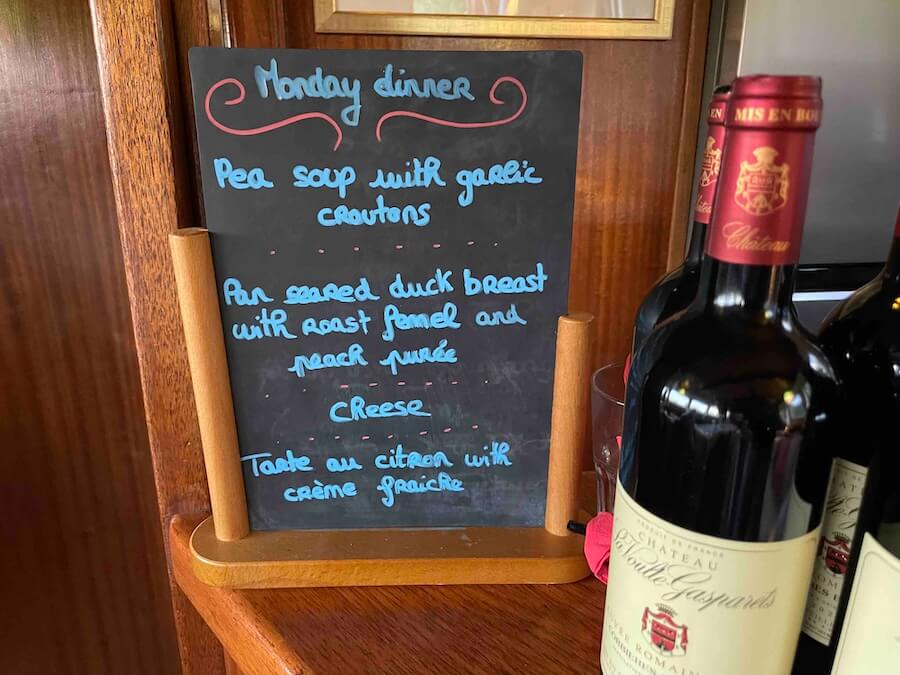
The dinner menu. * Photo: Peter Knego
After the wines were poured, dinner began with what was among the best pea soups I’ve ever tasted, thanks to its fresh ingredients and more than just a dash of garlic.
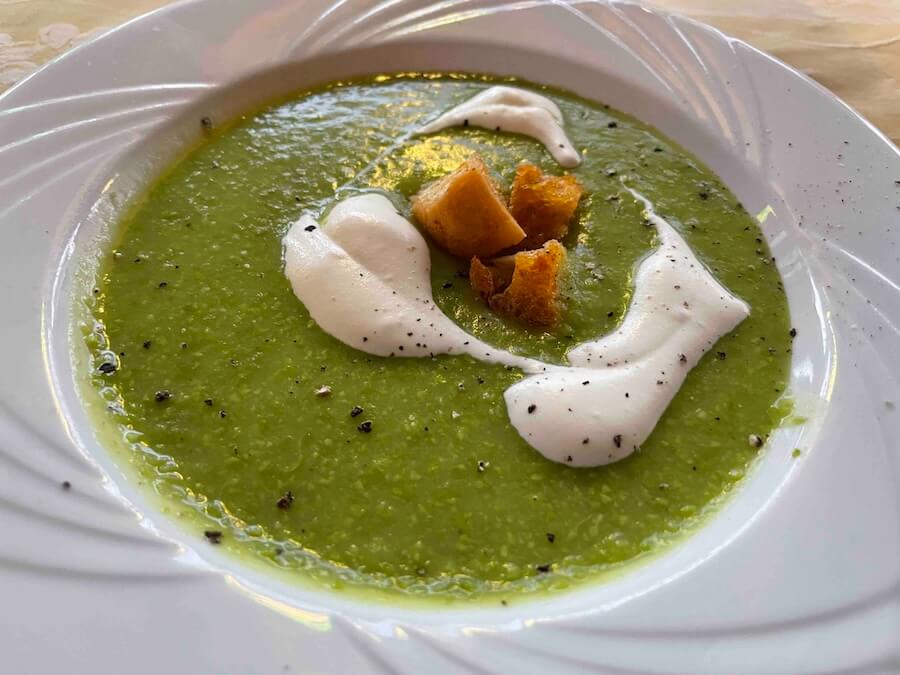
The pea soup starter. * Photo: Peter Knego
The main course was a seared duck with roasted fennel and a peach puree, in a perfect fusion of sweet and savory.
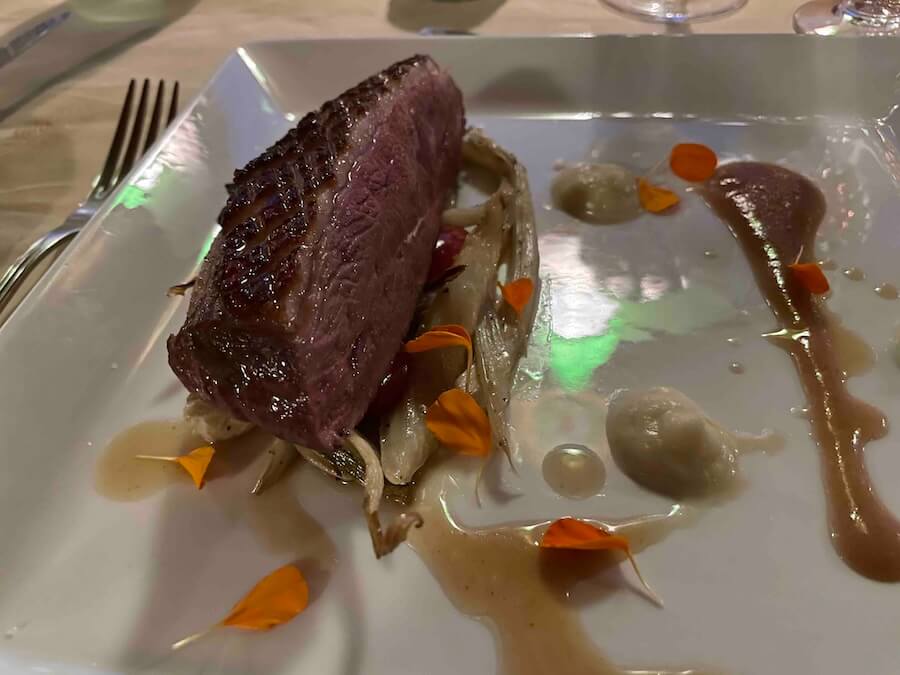
The duck main course. * Photo: Peter Knego
We polished off the dining experience with a crispy, delightfully sweet and sour lemon tart.
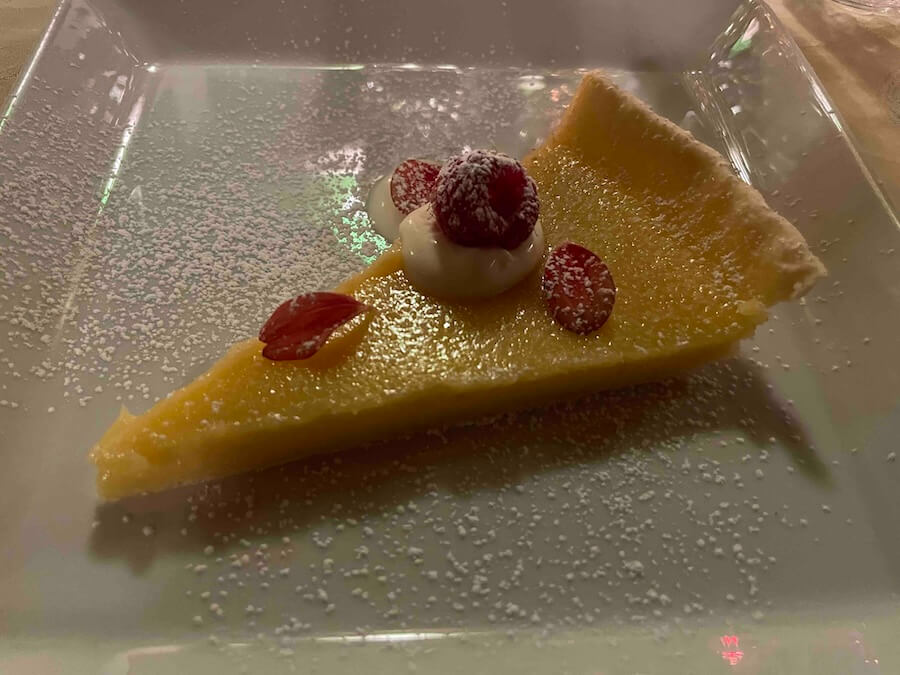
Lemon tart dessert. * Photo: Peter Knego
Just before retiring, we headed up to the Sun Deck to ogle the rising moon.

Moonrise over La Croisade. * Photo: Peter Knego
Day Three: La Croisade To Capestang
Day Three was a triple header that began with a morning visit to L’Oulibo, an olive press, where we were able to sample some of its olives and olive oils.
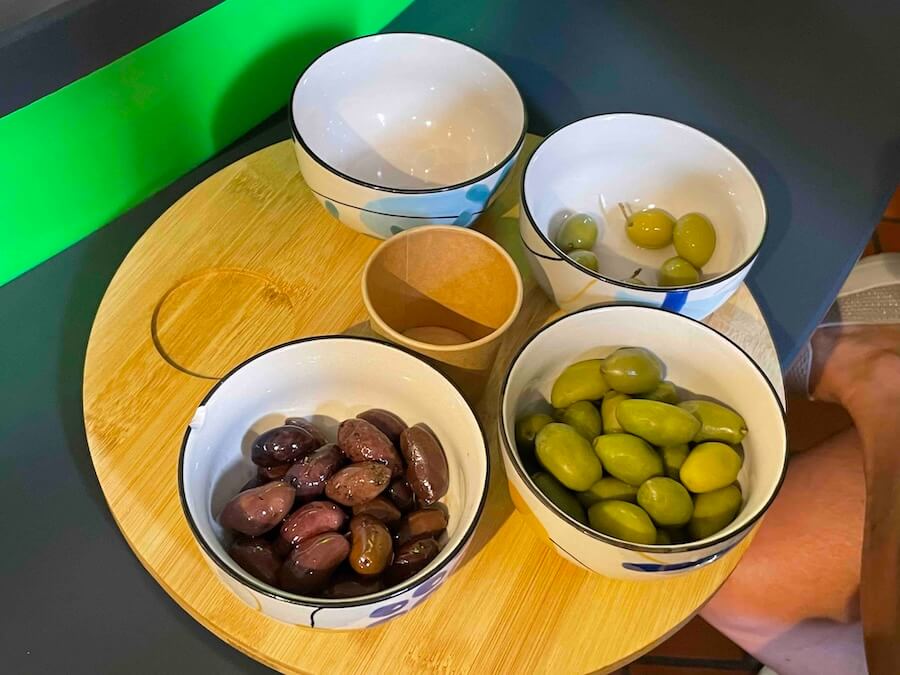
A selection of olives to taste at L’Oulibo. * Photo: Peter Knego
From there, we were off to the Black Mountains and the village of Minerve, which was built atop a plateau carved within a gorge by the River Cesse.

Approaching Minerve on a slightly gloomy morning. * Photo: Peter Knego
The natural beauty of the landscape, which included a huge tunnel that was also gouged out by the river, is quite breathtaking, although the history of the village itself is rather sad and distressing.
Minerve was a shelter for the persecuted Cathars, 140 of whom were burned at the stake by the Catholics in the early 13th century.
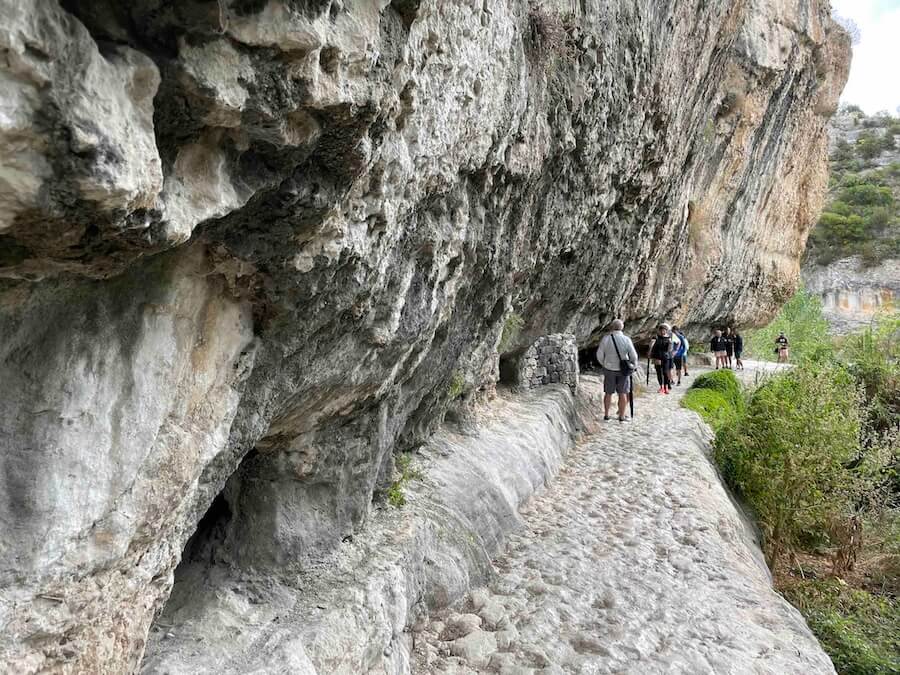
Walking along the sandstone bluffs at the base of Minerve. * Photo: Peter Knego
We returned to the Athos with an appetite that would be fully sated as we cruised eastward to the picturesque village of Capestang.

The Canal du Midi cuts through the village of Capestang. * Photo: Peter Knego
After a brief excursion to the nearby hilltop and Roman archaeological site of Oppidum d’Enserune, which overlooks a drained lagoon called Etang du Montady (another 13th-century engineering marvel), we were back at the Athos to enjoy a 5K run along the tow path before dinner.
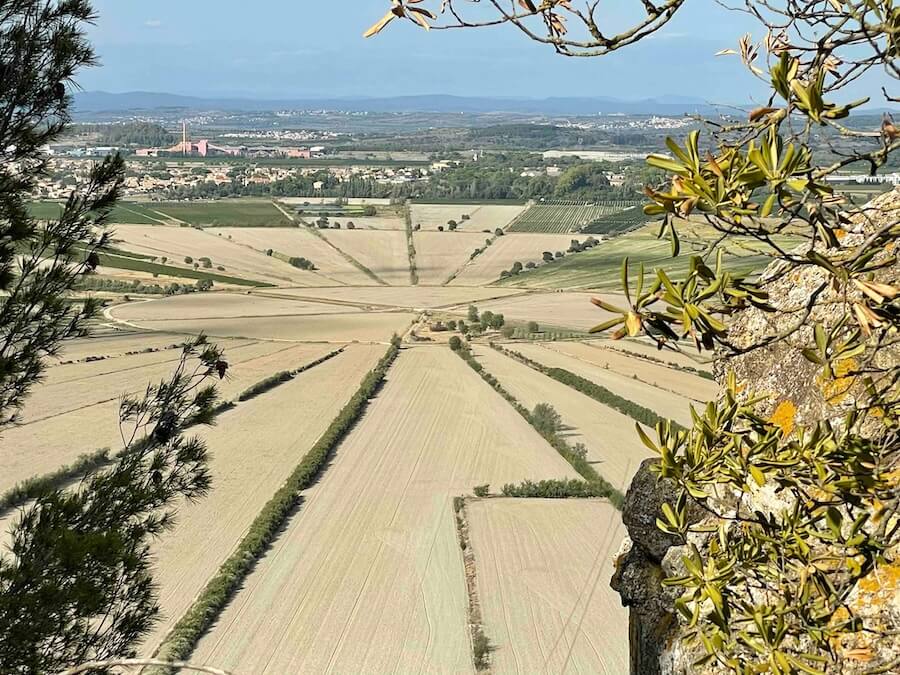
Overlooking Etang du Montady from the Oppidum d’Enserune. * Photo: Peter Knego
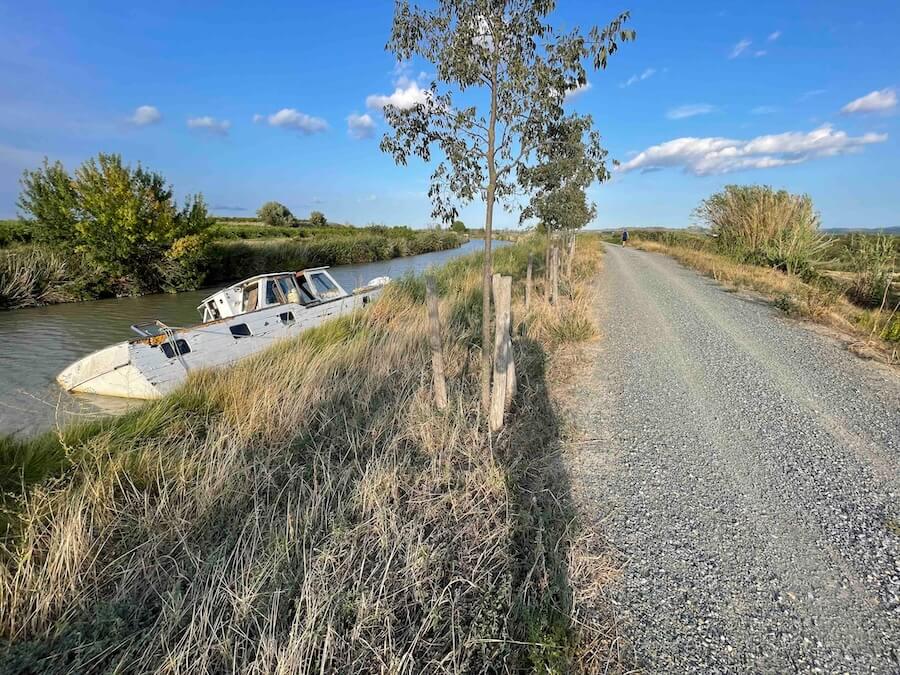
The tow path along the Canal du Midi was an excellent place to enjoy a refreshing 5K run. * Photo: Peter Knego
The main course was, according to fellow guests, a superb crab cake.
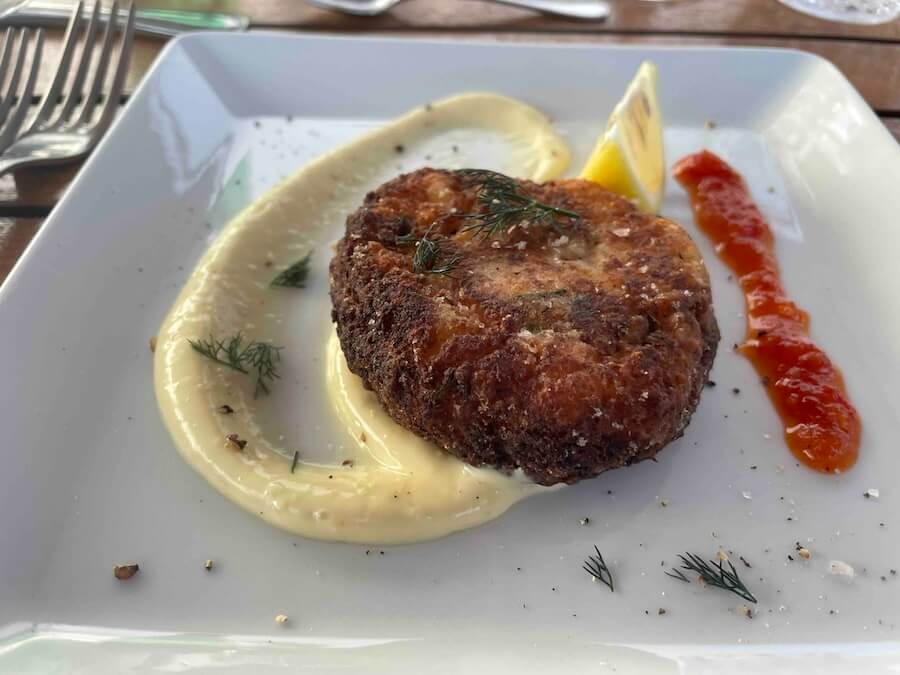
Crab cake main course. * Photo: Peter Knego
However, I think I fared even better with a veggie substitution that may have been my favorite course in a week of superlative dining.
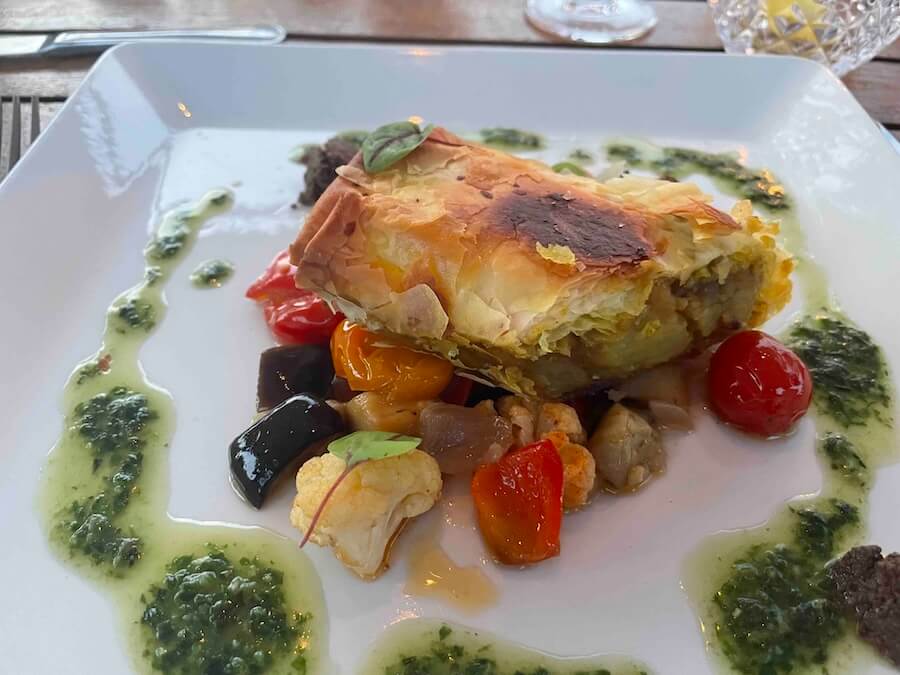
Drizzled in basil and olive oil, filo dough crusted veggie alternate entrée. * Photo: Peter Knego
Day Four: Capestang To Fonserannes
On day four, we were off in the mini-vans due south to Narbonne, which is situated on the Canal de la Robine, another historic waterway that connects with the Canal du Midi.

The Canal de la Robine, an adjunct of the Canal du Midi, flows through the heart of Narbonne. * Photo: Peter Knego
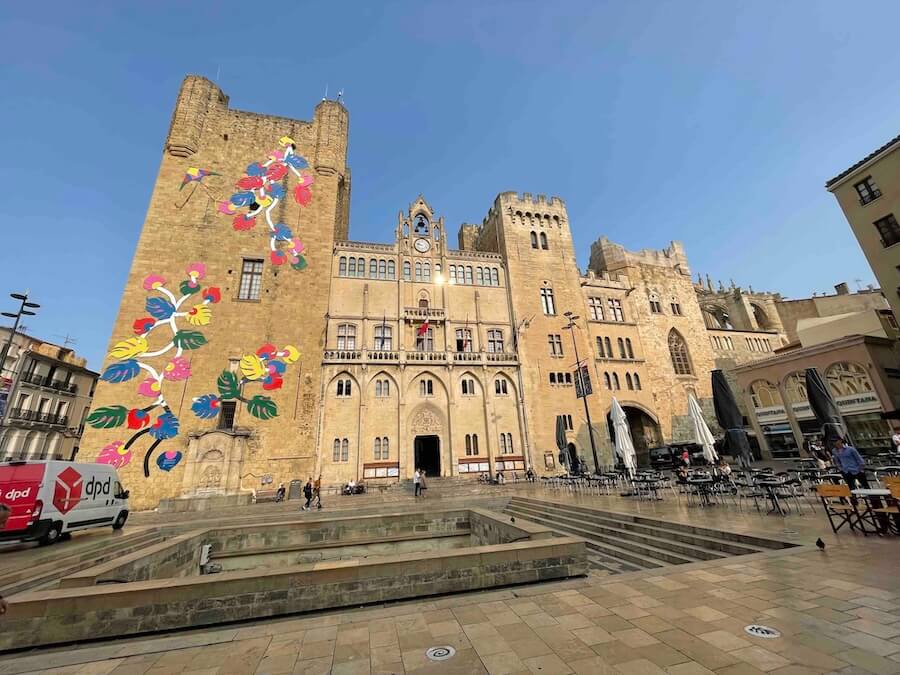
Our tour of Narbonne began in the city square in front of the Palais des Archeveques (Archbishops). * Photo: Peter Knego
Matthieu gave us a tour of the main city square, which is built atop a section of the Roman Via Domitia road that connected Rome with Spain.

An excavated portion of the Via Domitia with a cigarette butt and popsicle stick to give it that modern flourish. * Photo: Peter Knego
Our tour encompassed the 13th-century Palais des Archeveques (Archbishops) and the towering Cathedral of Saint-Juste, which was left unfinished with open courtyards under stone frameworks. The gargoyles overlooking its cloisters were worth the visit and then some.
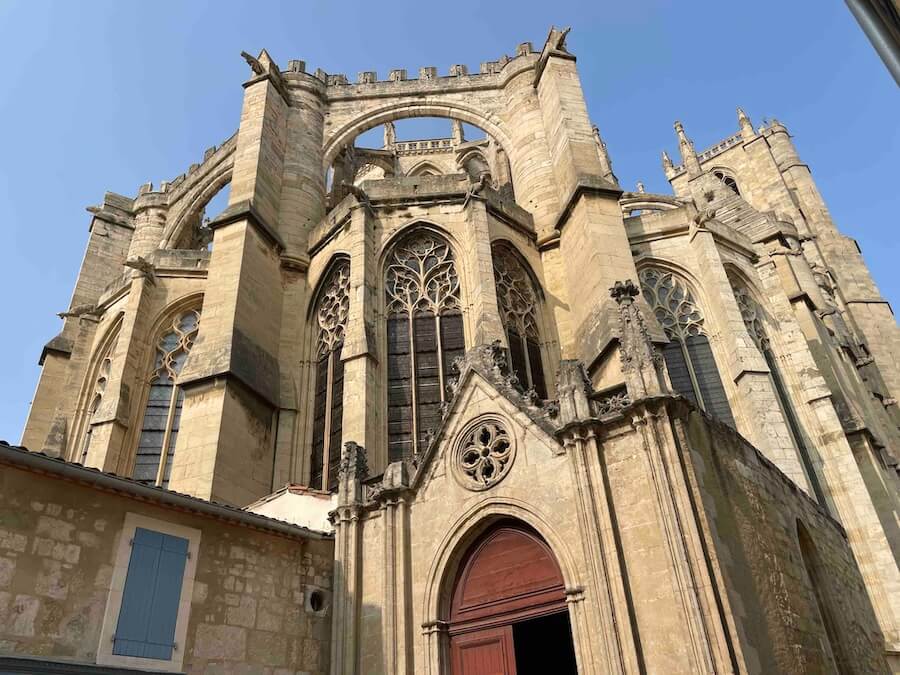
The facade of the Cathedral of Saint-Juste. * Photo: Peter Knego
After time on our own to shop, we met at the Les Halles marketplace for lunch at Chez Babelle, which is run by a former professional rugby player whose children own the adjacent butcher shops.

The owner of Chez Babelle, a former rugby player and now a local legend, catches the next course in the backdrop as we dine away. * Photo: Peter Knego
When an order is placed, the owner blows a whistle and the meats are thrown across or down to him in an ongoing ritual of catching prowess and showmanship.
Back at Athos, we were underway once more, passing through more gorgeous terrain, this time along a bluff overlooking the vineyards of Herault.
We would also pass through another engineering feat, the 541-foot-long Tunnel du Malpas, which Riquet had carved out of a sandstone mountain in a mere eight days.
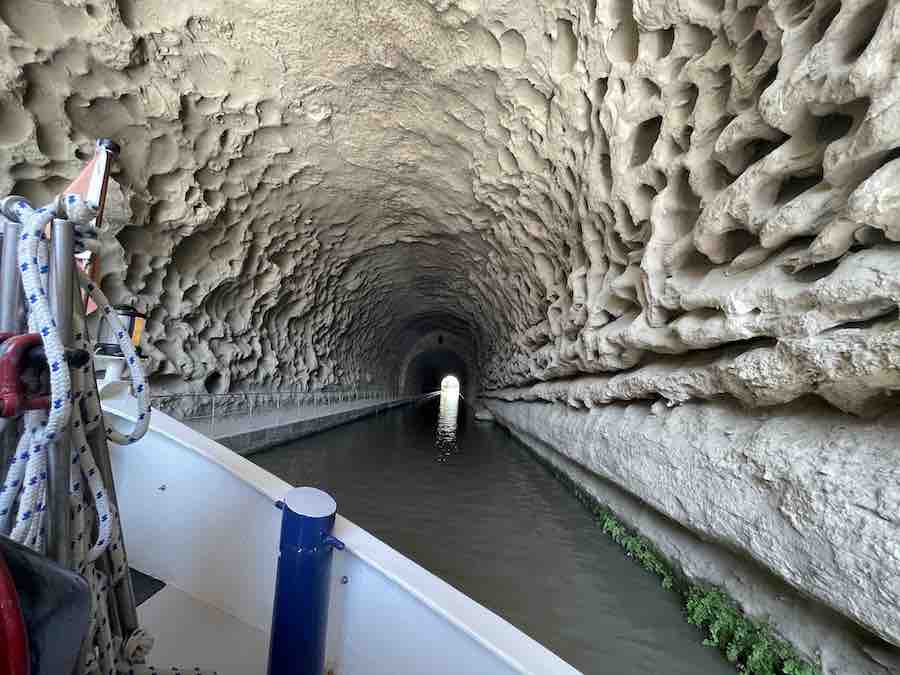
The Tunnel du Malpas, an engineering marvel within an engineering marvel. * Photo: Peter Knego
Shortly after, we had a chance to put the whirlpool tub on deck to use and, later, with Beziers Cathedral of St. Nazaire looming in the distance, we tied up at Fonserannes, just aft of Athos’ European Waterways fleet mate, the eight-passenger deluxe barge Anjodi, which was built in 1929.

Mike enjoys the whirlpool as Athos cruises towards Fonserannes. * Photo: Peter Knego
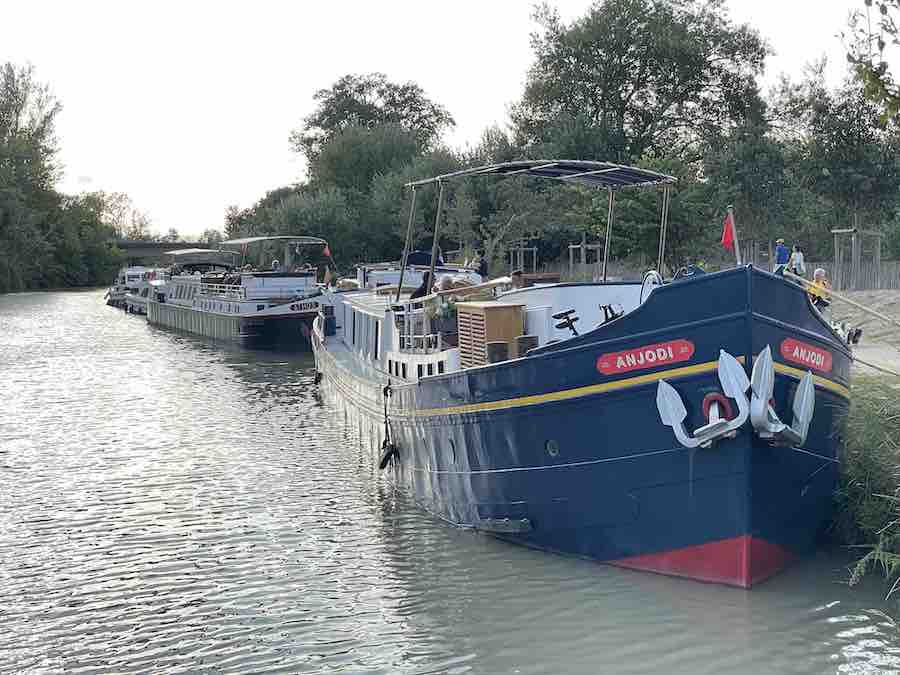
The 1929-built Anjodi, also operated by European Waterways, cruises both the Canal du Midi and along the Rhone. * Photo: Peter Knego
RELATED: Read Judi Cohen’s review of the lovely Anjodi.
Before dinner, I had time to wander Fonserannes staircase of seven locks, watching as small rental boats navigated their way upwards in a maneuver we would do in reverse the following morning.
Day Five: Fonserannes To Portiragnes
The fifth day began with an excursion to Pezenas, a town that Moliere once frequented with his theater troupe. Today, it is known for its artisanal shops and charming old town, which we toured before having time on our own to shop or indulge at a cafe.
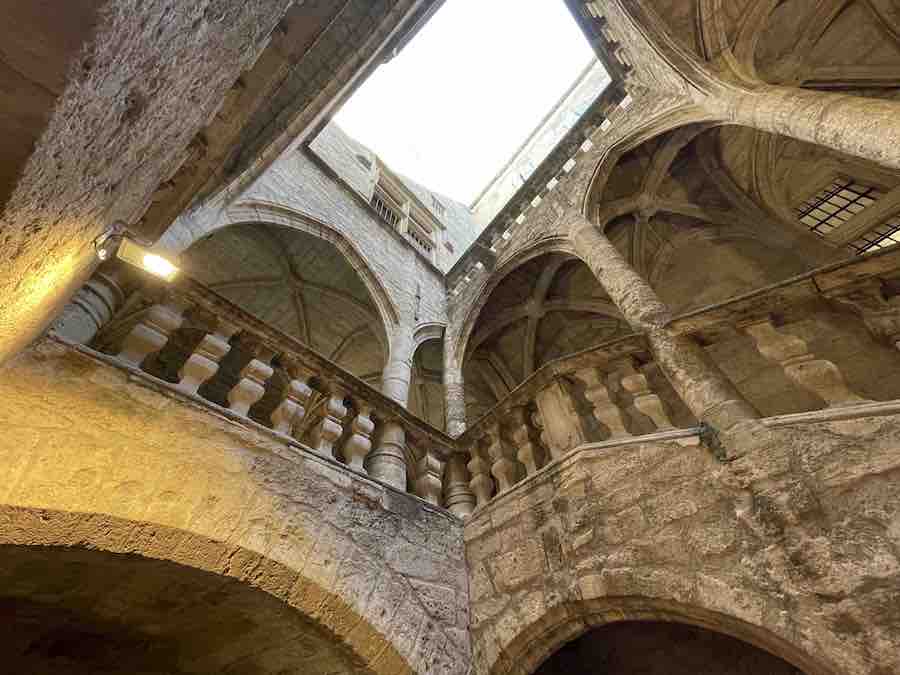
Courtyard of Pezenas. * Photo: Peter Knego
Pezenas has an interesting and free Musée des Portes (Museum of Doors) which was well worth a visit, especially because it was free of charge.
Back at the Athos, lunch accompanied our entry and descent of 71 feet through the locks, which are still functioning beautifully after 342 years of use.

Matthieu looks on as Athos enters to uppermost lock of the Fonserannes staircase. * Photo: Peter Knego
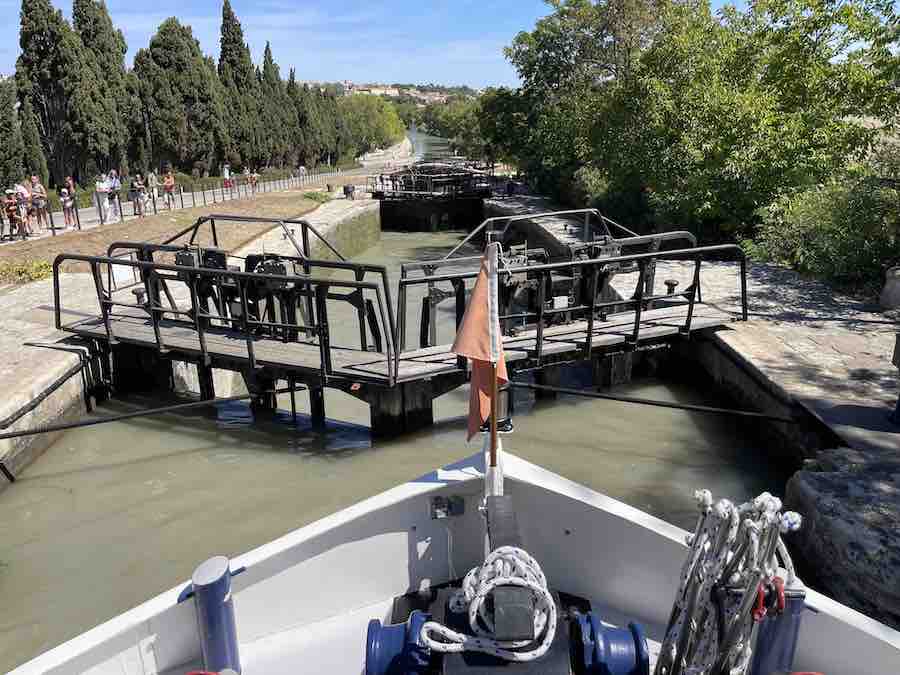
Athos begins her descent at Fonserannes. * Photo: Peter Knego
The lock master would not let us off the barge to take pictures of the canal transit, which was a little frustrating but lunch was so good, few of us would have probably done so, anyway.
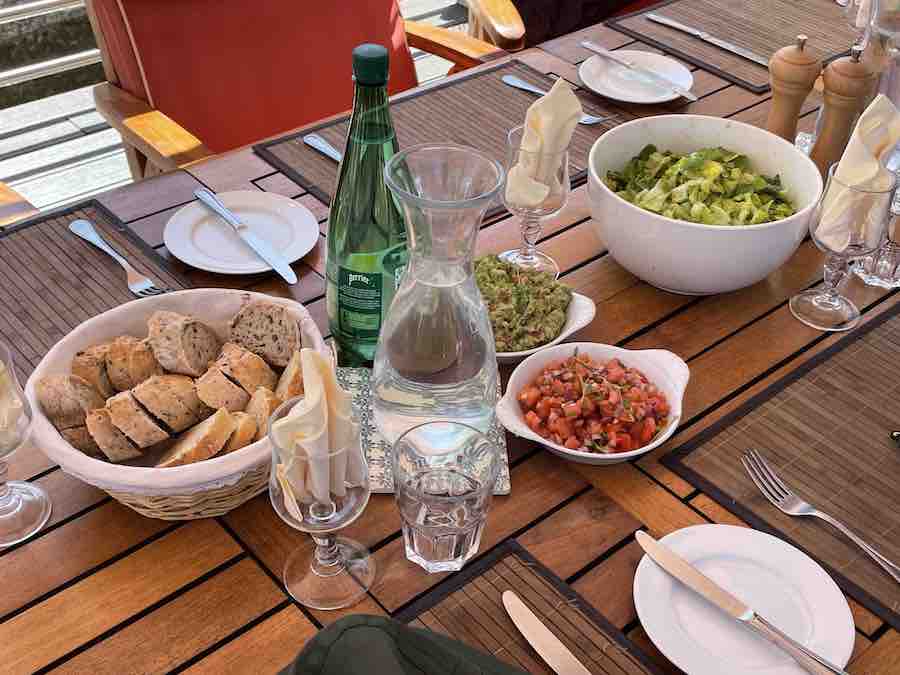
Lunch began with the best guacamole and pico de gallo in the Old World, along with a fresh caesar salad. * PhotoL Peter Knego
Once cleared, Athos proceeded through the aqueduct built in 1858 to cross over the River Orb. Originally, the Fonserranes Locks descended to river level but the river, itself, occasionally overflows and creates havoc with the canal traffic, so the bypass was built as a solution.

Crossing over the River Orb via the Aqueduct at Beziers. * Photo: Peter Knego
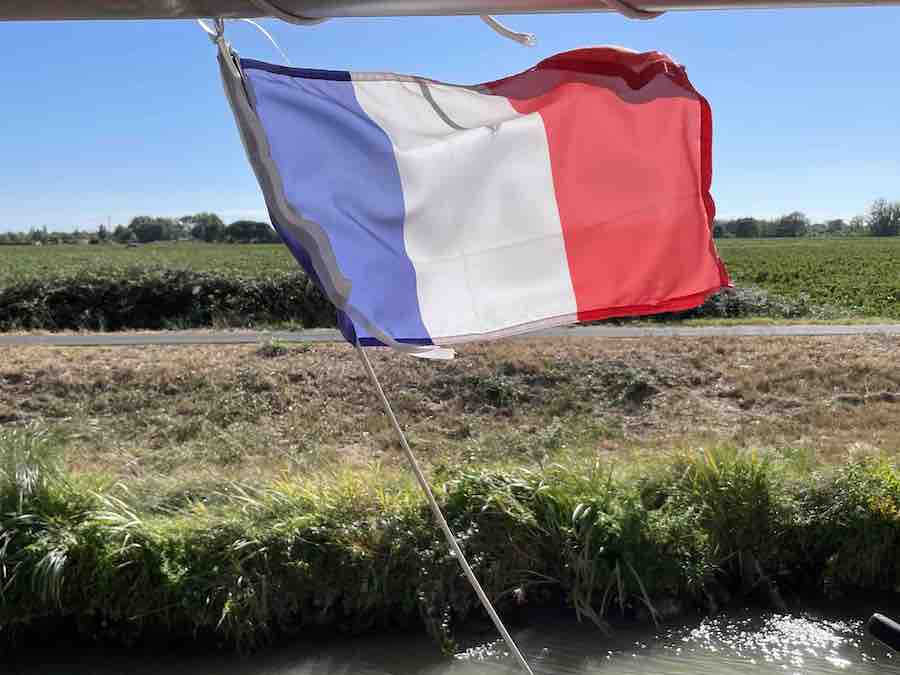
The French tri-color billows over the canal. * Photo: Peter Knego
After crossing the bridge, Athos descended two more locks and then continued on her way to a mooring near Portiragnes, where the avid cyclers in our group were given a chance to ride some 10 kilometers to the local beach.

Avid e-biker Mike is ready to roll! * PhotoL Peter Knego
Meanwhile, I rode in a van with the other non-bikers to the beach for a refreshing run in the surf.
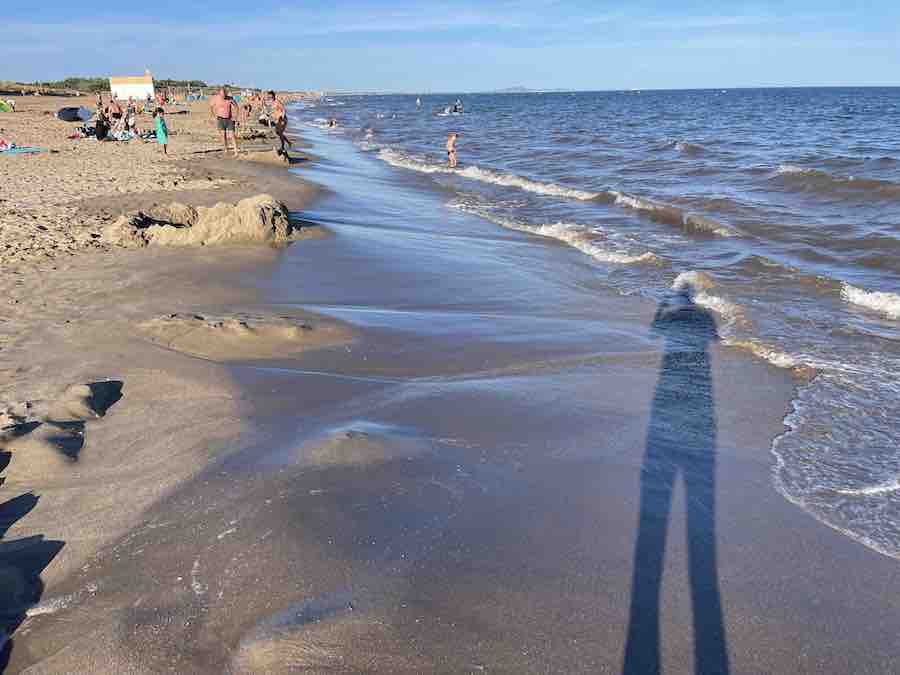
Pausing during a run in the surf at Plage Portiragnes. * Photo: Peter Knego
That evening, as dinner was served on deck, we watched as the then full moon cast its rising reflection over the canal.
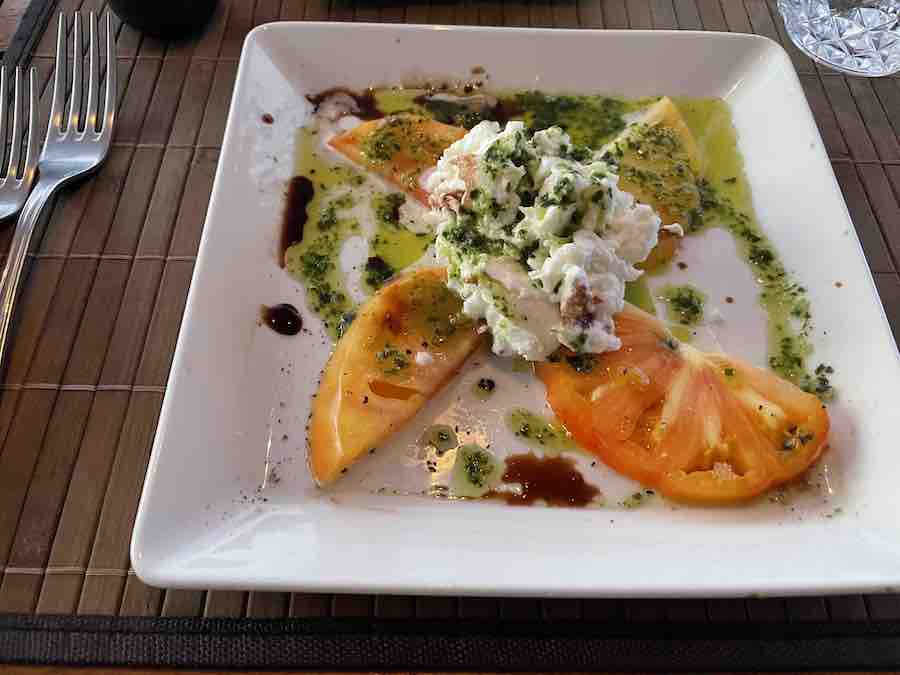
As tasty as it was photogenic, the tomato and goat cheese dinner starter. * Photo Peter Knego
Day Six: Portiragnes To Marseillan
The next morning gave us our one and only chance to sleep in a bit as Athos glided along to Marseillan. We were up in time to consume the last remnants of breakfast and took our coffees up on deck as we entered what is called a round lock, where the canal converged with the Herault River at the town of Agde, offering a choice of going south along the river or continuing east with the last segment of the canal.
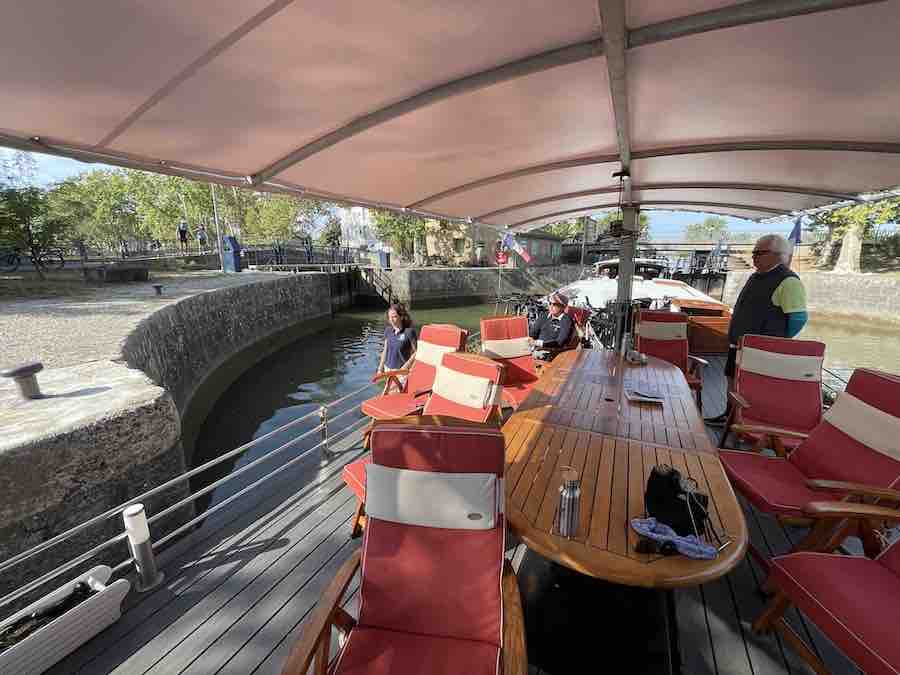
Athos enters the “round lock” of Agde. * Photo: Peter Knego
Along the way, we marveled at flocks of migrating birds and the combination rural and suburban landscapes as they unfolded.
Around noon, we were passing through wetlands near the village of Les Onglous prior to entering the Etang de Thau.

Cruising past picturesque Les Onglous near the eastern terminus of the canal. * Photo: Peter Knego

Happy cruisers on our final day of navigating the Canal du Midi. * Photo: Peter Knego
A slight breeze on the Etang made it feel almost as if we were at sea with the expansive salt water lagoon unfolding before us.
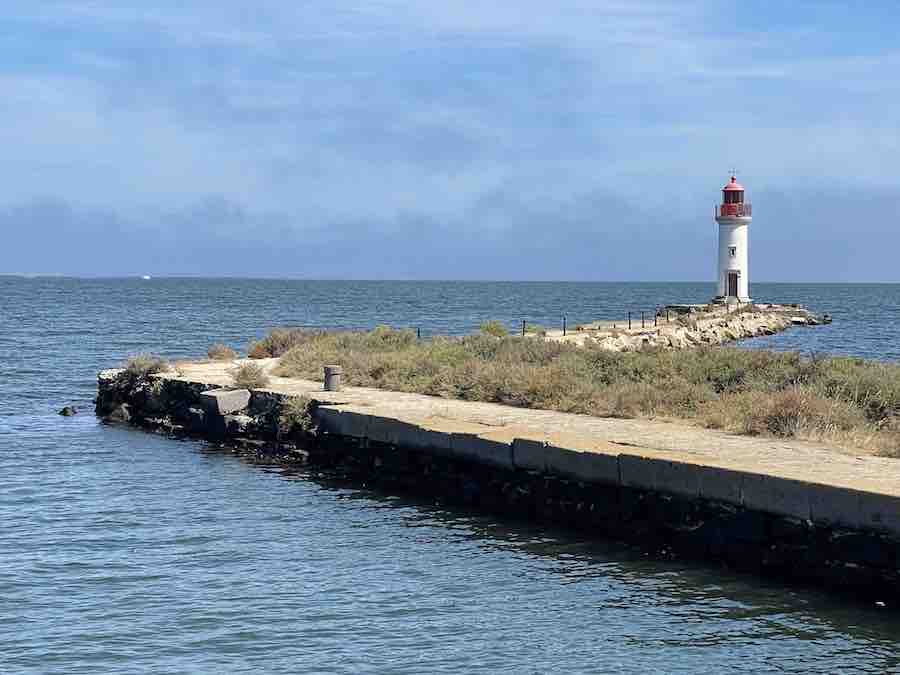
The lighthouse at the entrance to Etang de Thau. * Photo: Peter Knego
Captain Pierre Yves anchored us for a short time above the mussel beds that provided the main course for lunch. It was a lovely way to end our transit of the canal before Athos tied up at the charming outpost of Marseillan, which has a small harbor lined with shops.
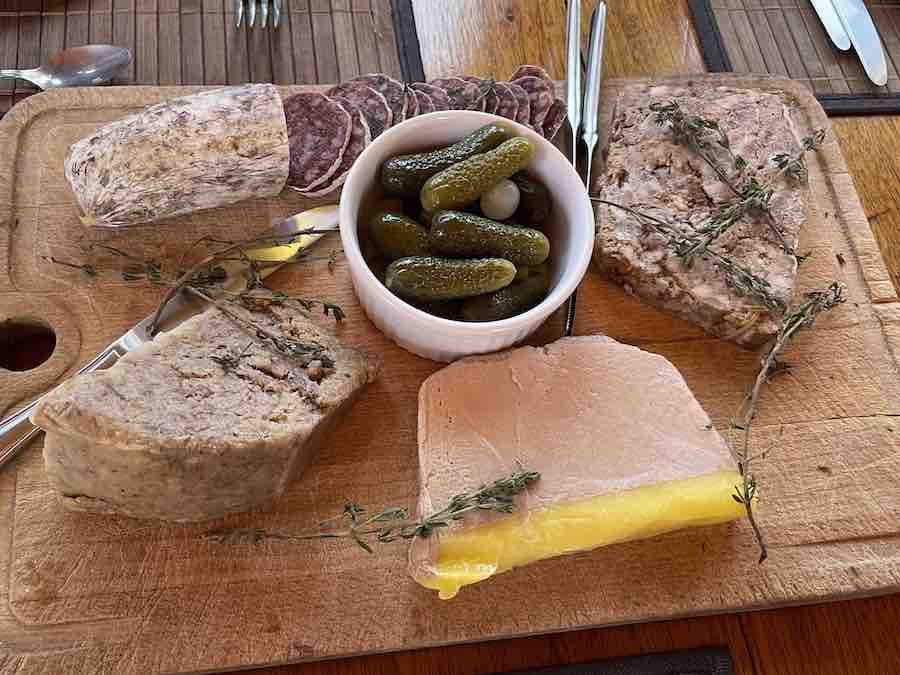
A choice charcuterie selection began our final lunch. * Photo: Peter Knego
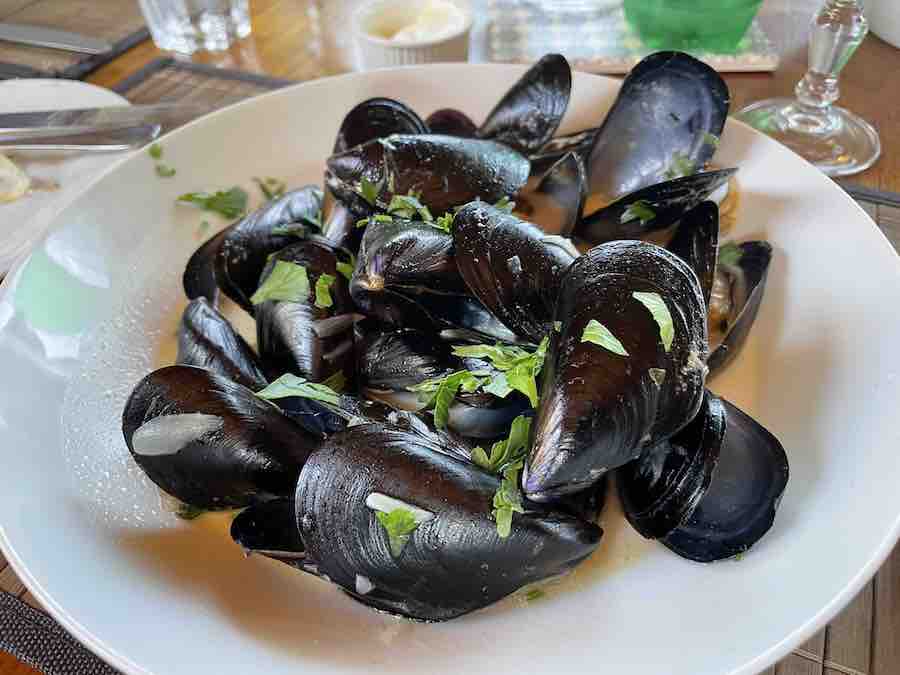
“I want mussels!” was a lunch request fulfilled for Athos guests. * Photo: Peter Knego
Most of the guests went to the afternoon vermouth tasting at the world renowned Noilly Prat distillery, which is something we had just recently done on another cruise, so we just wandered the town. There was another bike outing that followed but I chose to indulge my cardio vascular system with a 5K run along the shores of the lagoon.
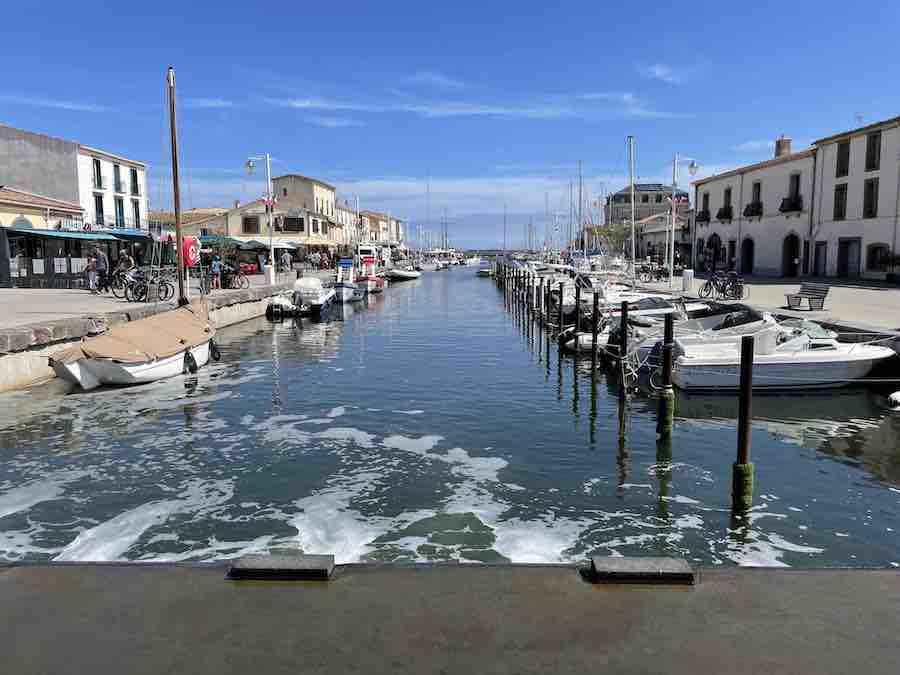
Marseillan, the beginning or ending point on European Waterways Canal du Midi cruises, has a picturesque marina that adjoins the Etang de Thau. * Photo: Peter Knego
Back aboard, we packed, then joined our fellow voyagers for a gala final dinner, which featured fresh oysters from the Etang.
Captain Pierre-Yves and Matthieu joined us in the lounge, where we were able to share many toasts and reflect on our adventurous and scenic week along the canal.
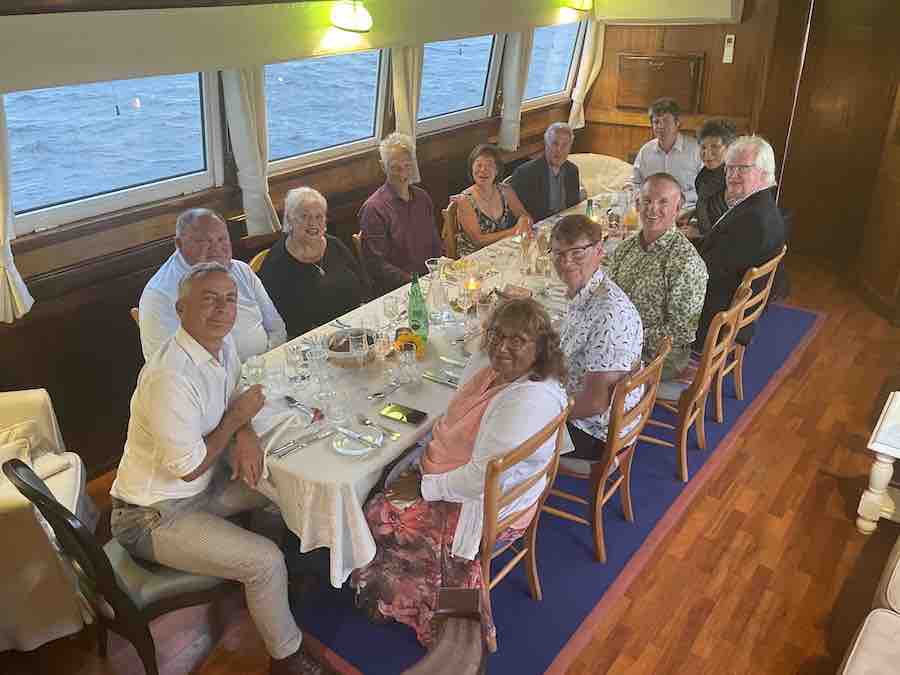
Our last supper was hosted by Captain Pierre-Yves (rear) and host Matthieu (left). * Photo: Peter Knego
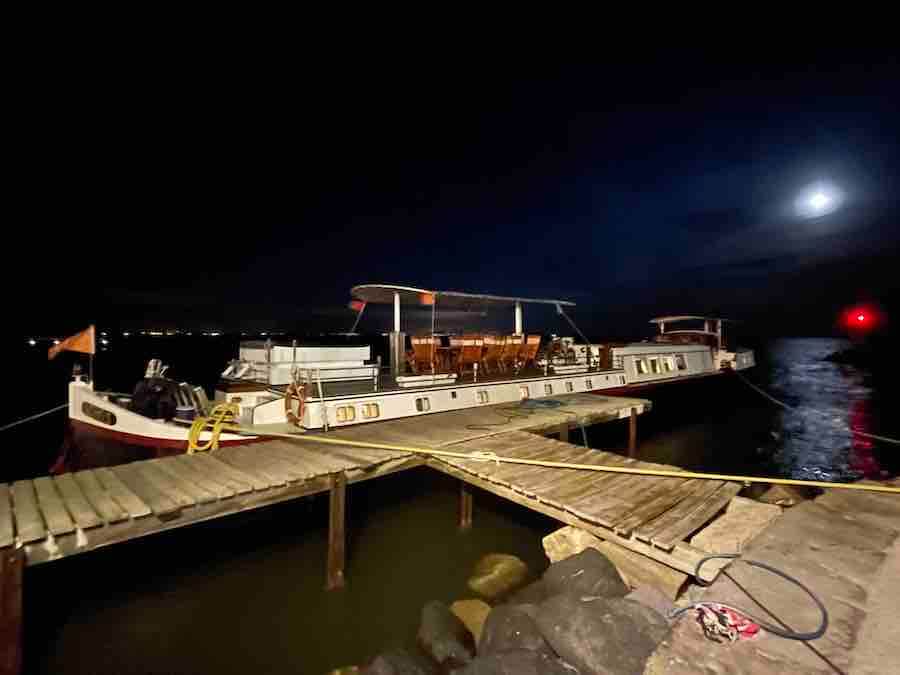
A hovering moon over Marseillan and Athos marked the end of our epicurean journey. * Photo: Peter Knego
Day 7: Marseillan to Beziers
The next morning, it poured rain as we were shuttled off in our minivans to Beziers, where it had all begun.
Interested in This South Of France Barge Cruising Adventure?
Fares start at $7,795 per person, double occupancy, in the shoulder season; $8,295 in value seasons; and $8,595 in high season.
Shoulder season is March 31 – April 27 and October 27 – November 2
Value season is April 28 – May 4, July 7 – August 10 and October 20 – October 26.
High season is May 5 – July 6, and August 11 – October 19.
Don’t miss a post about small-ship cruising, subscribe to QuirkyCruise.com for monthly updates & special offers!
© This article is protected by copyright, no part may be reproduced by any process without written permission from the author. All Rights Reserved. QuirkyCruise.com.

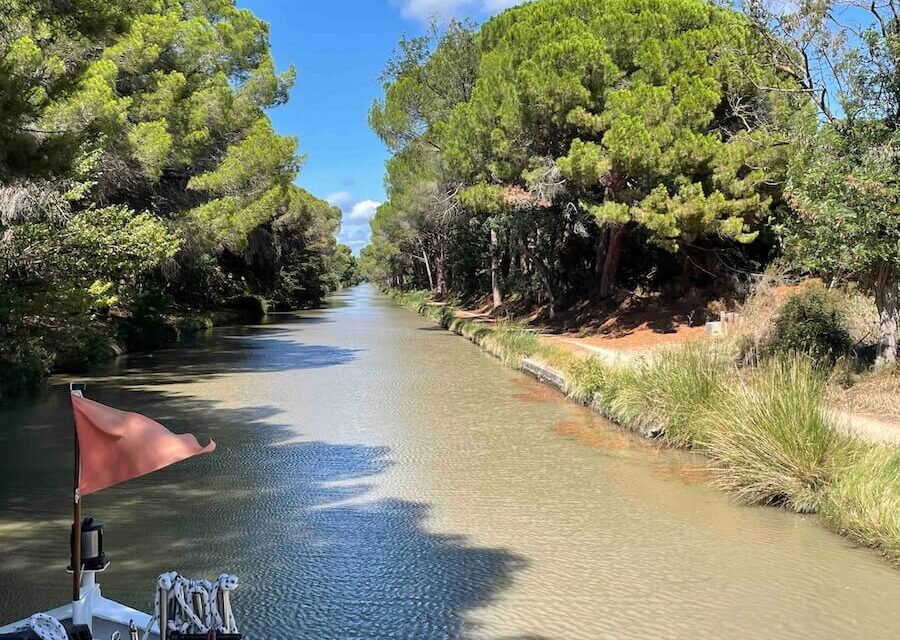
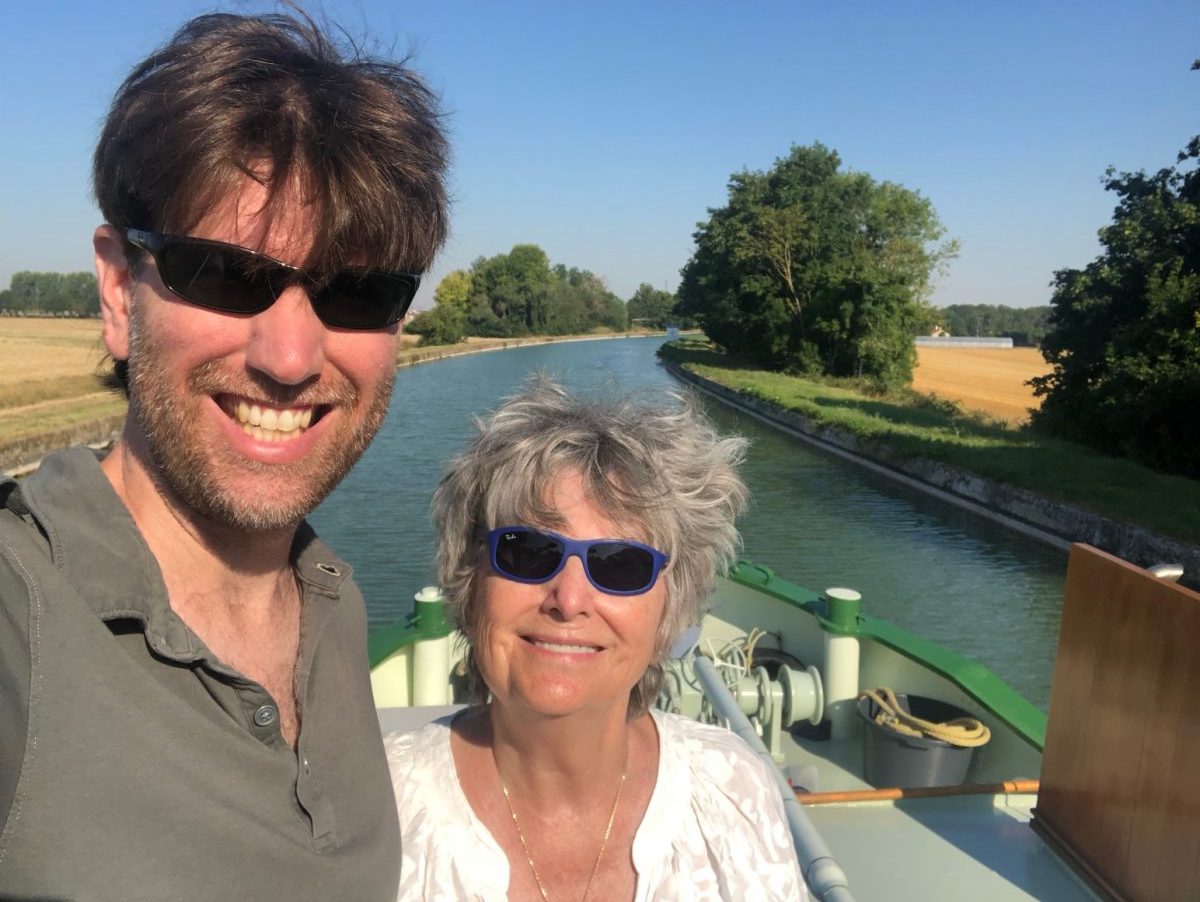

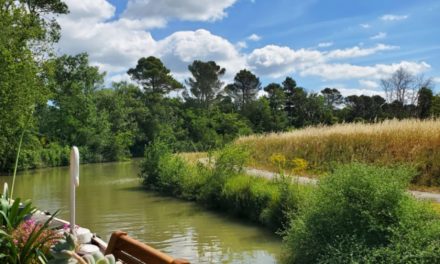
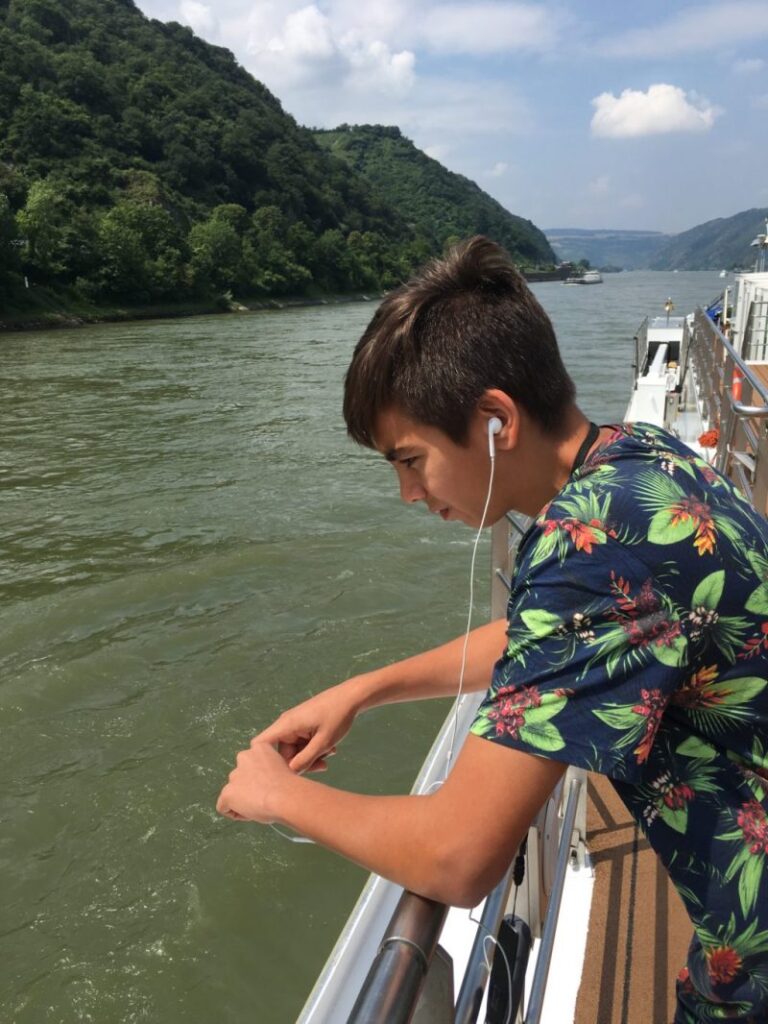
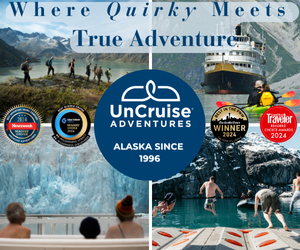


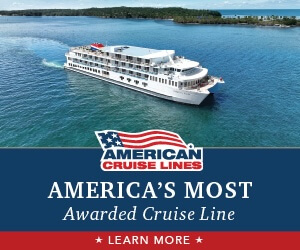




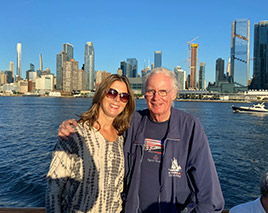 HEIDI SARNA
HEIDI SARNA
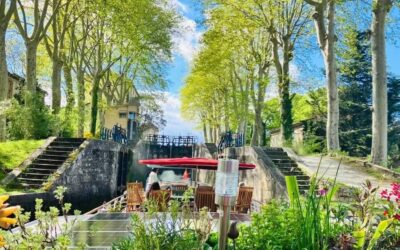


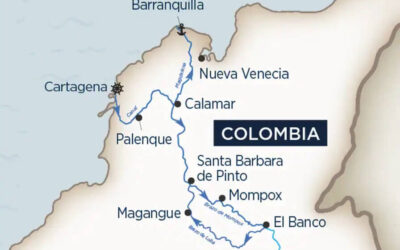
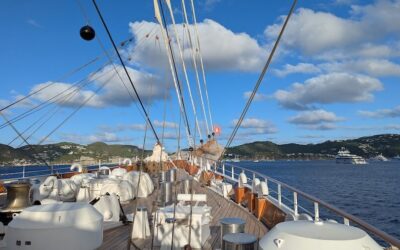
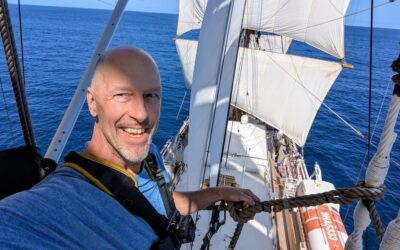
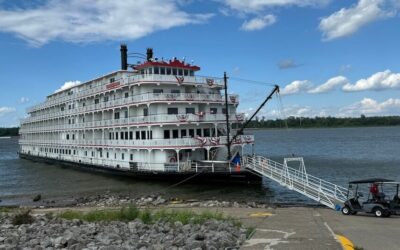
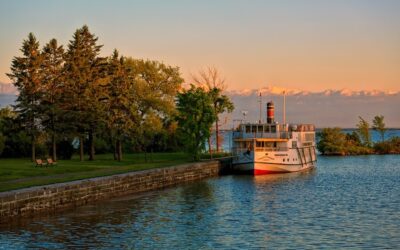

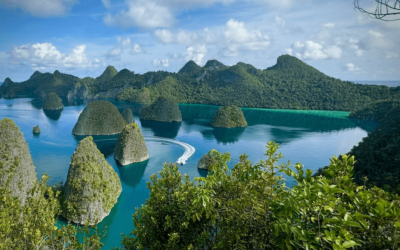


Wonderful story, with Peter’s characteristic attention to detail and great photos. It really hits home how many beautiful, history-rich corners of the world there are to explore on small vessels. And the food looks exquisite. My mouth is watering for that pea soup, the goat cheese starter and, and, and …